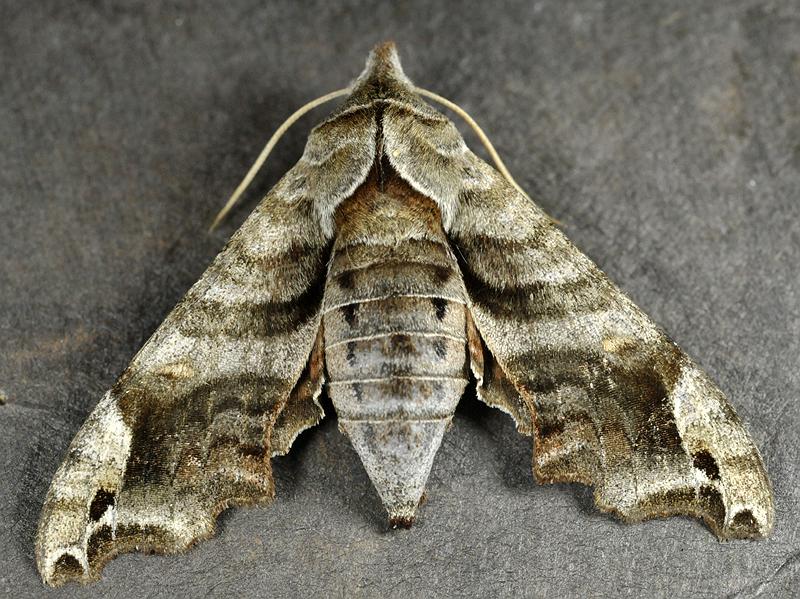

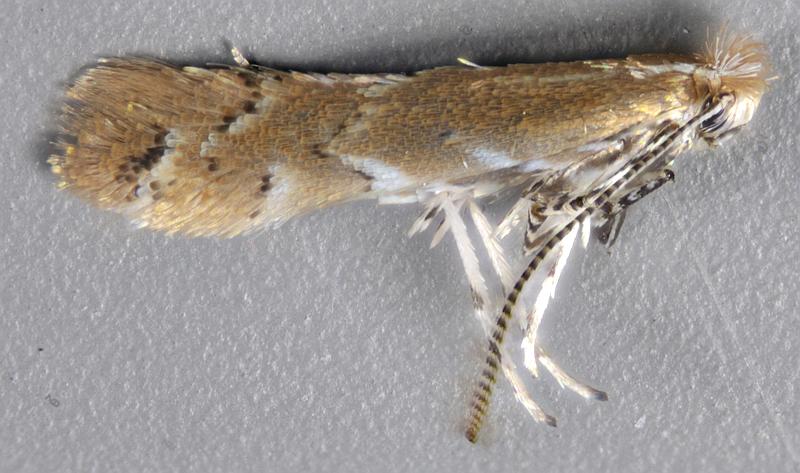

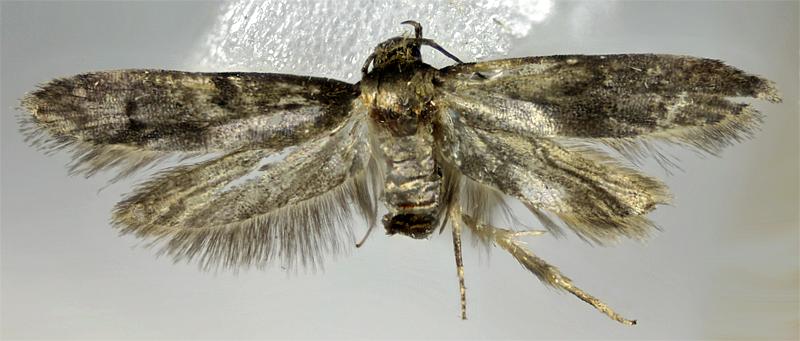
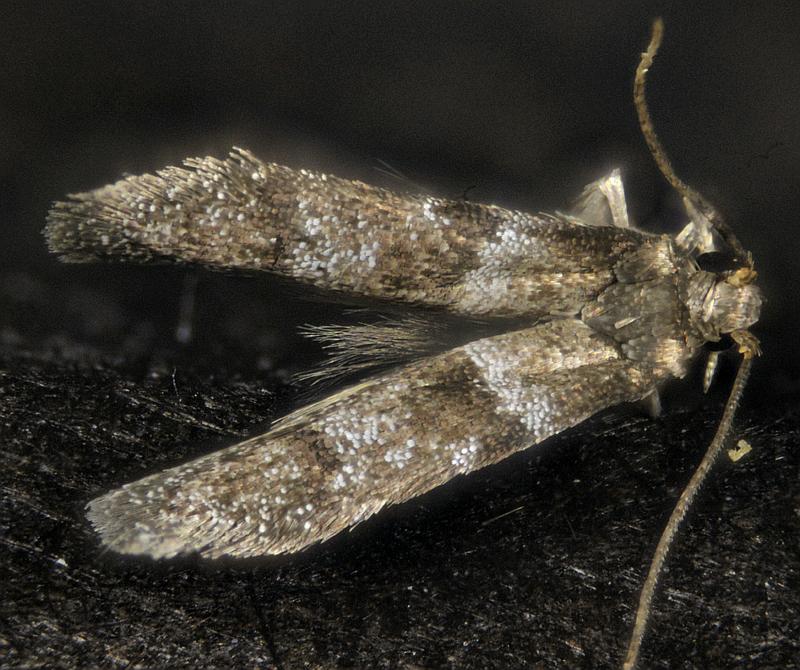

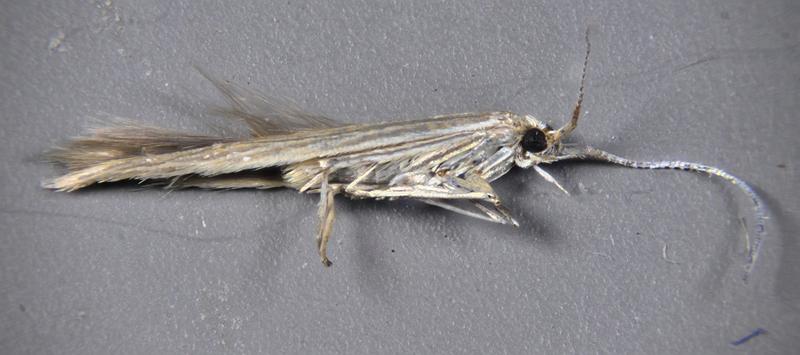

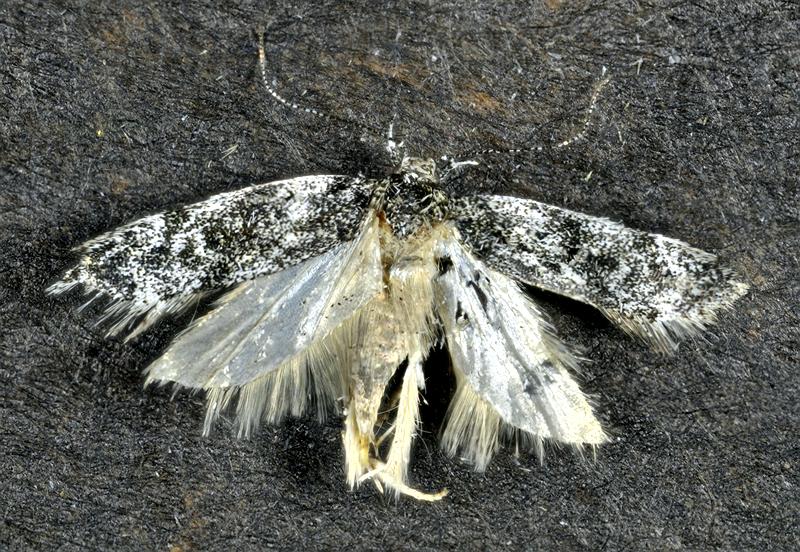

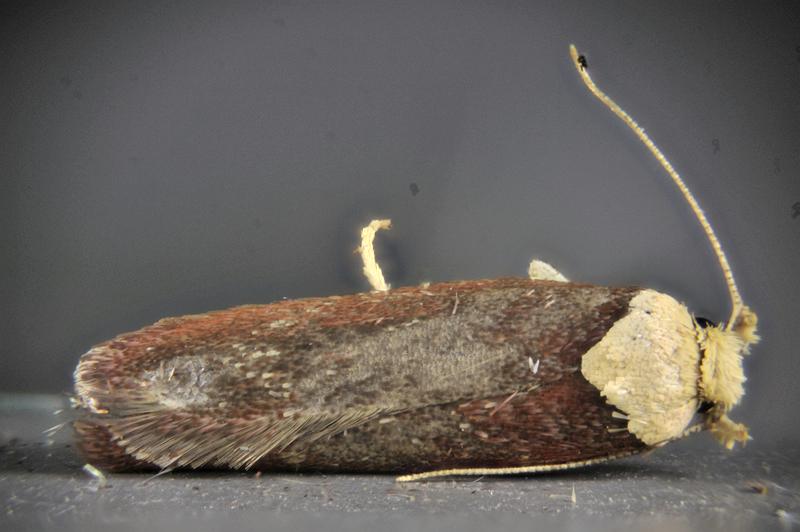

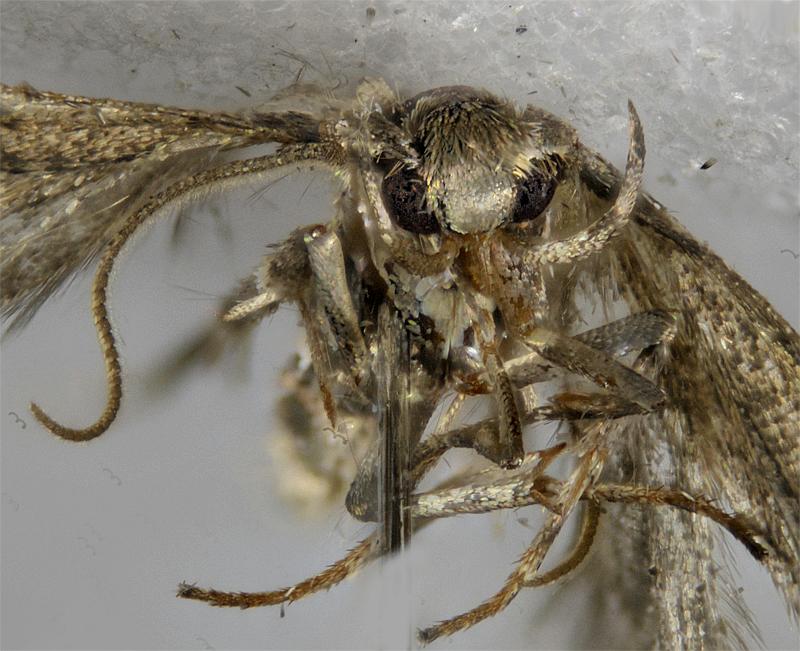

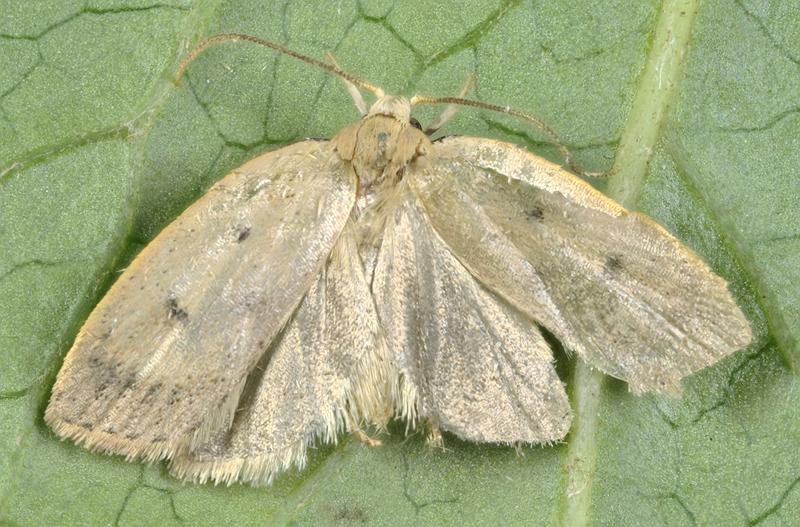

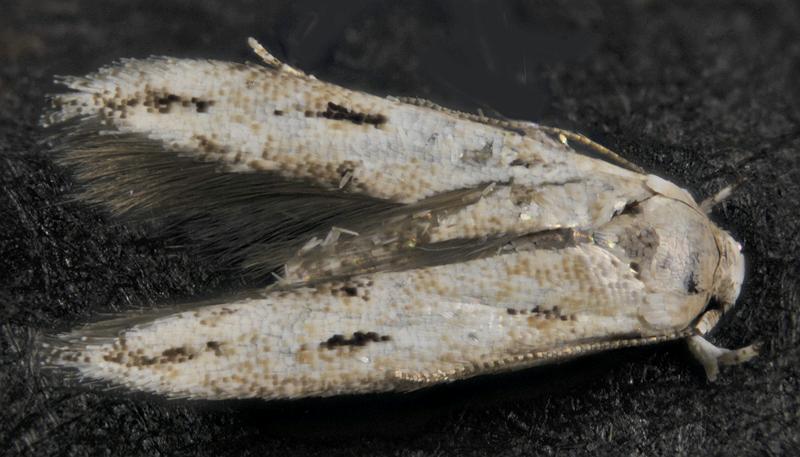

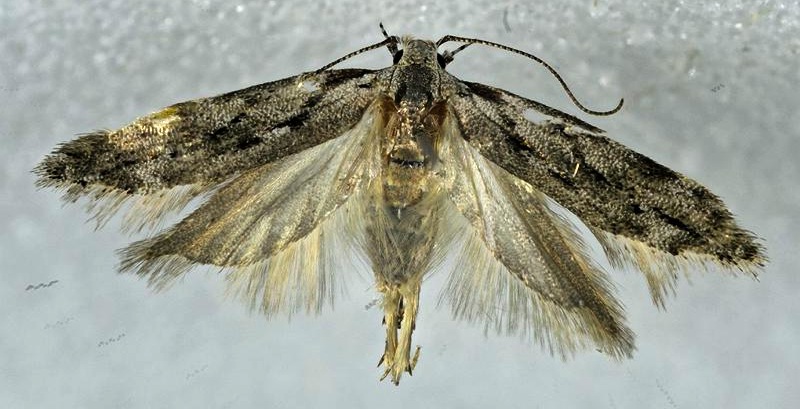

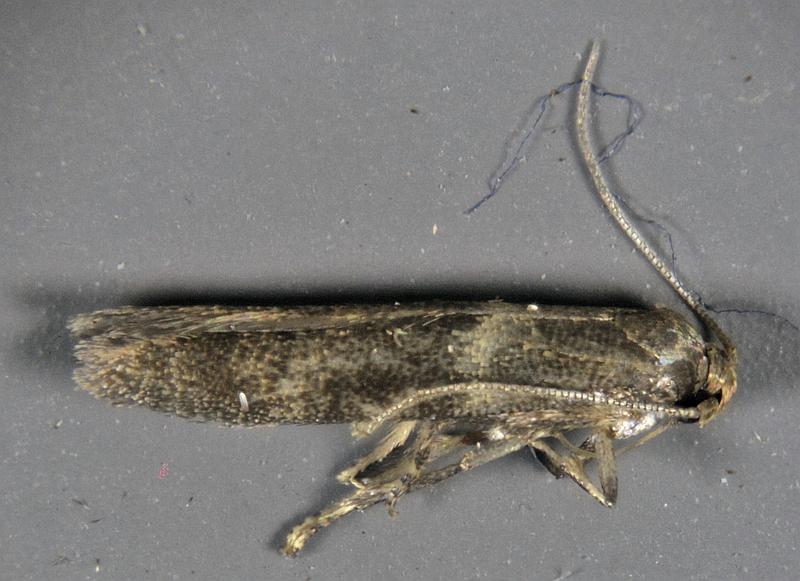

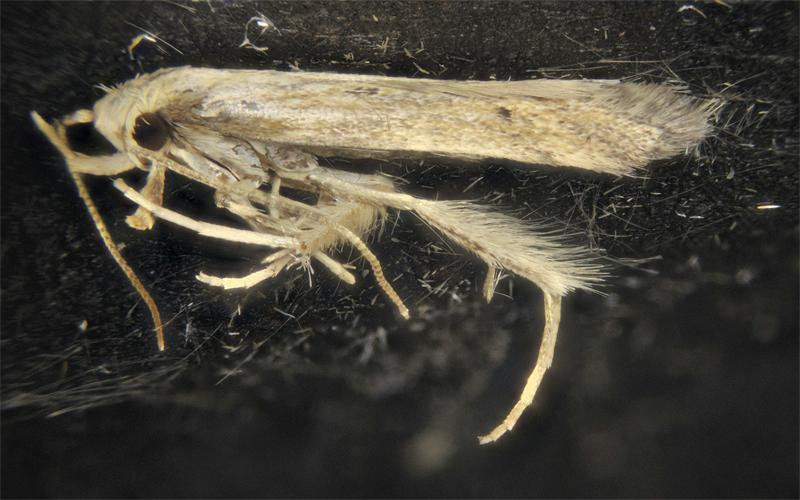

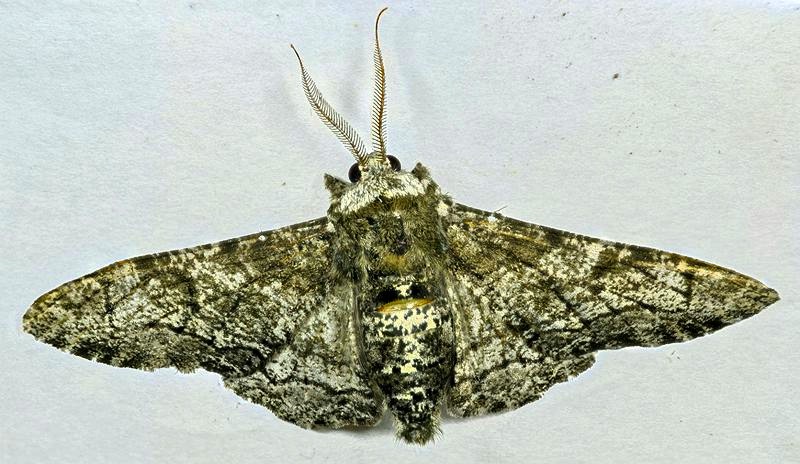

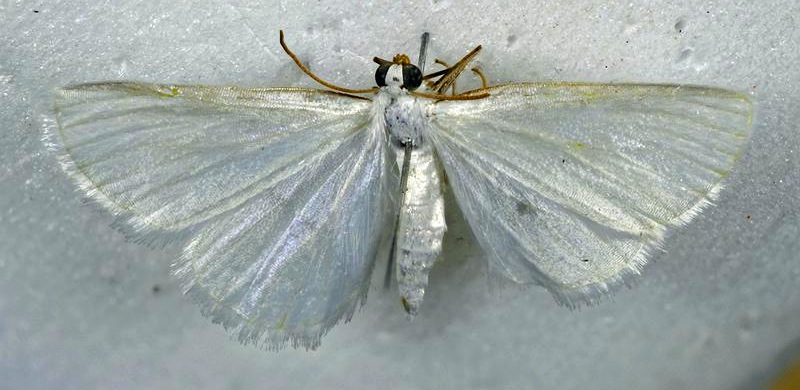

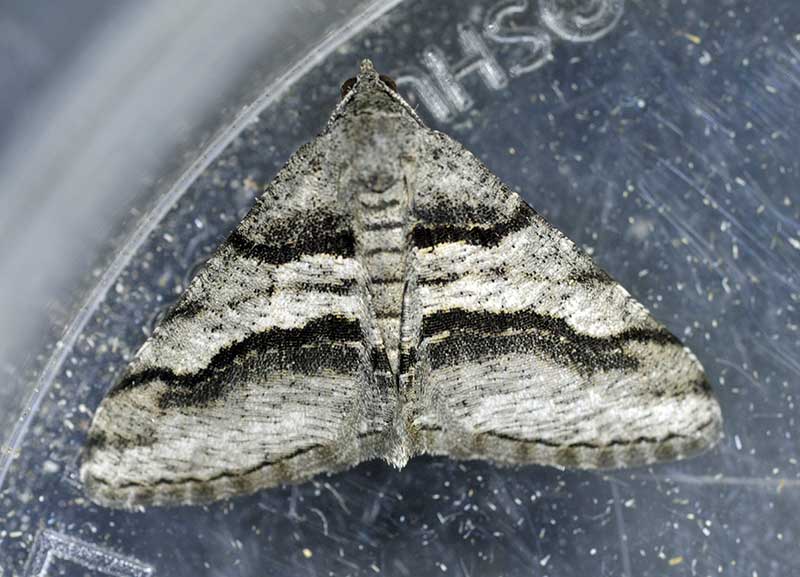

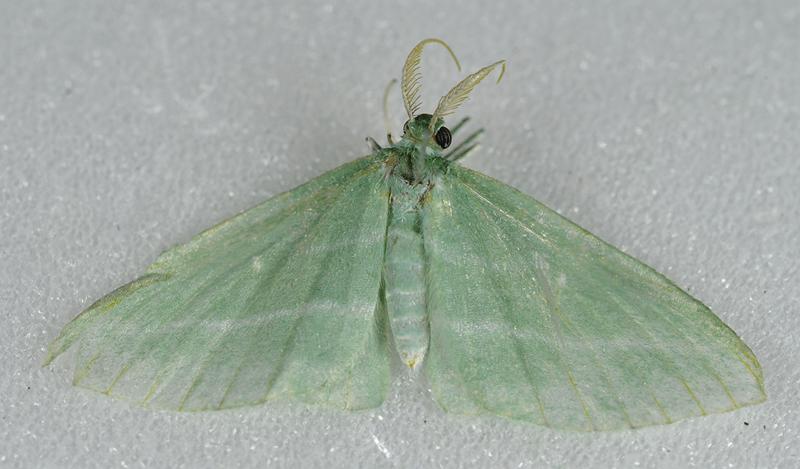

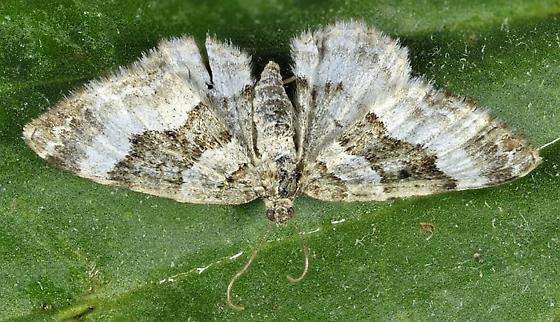
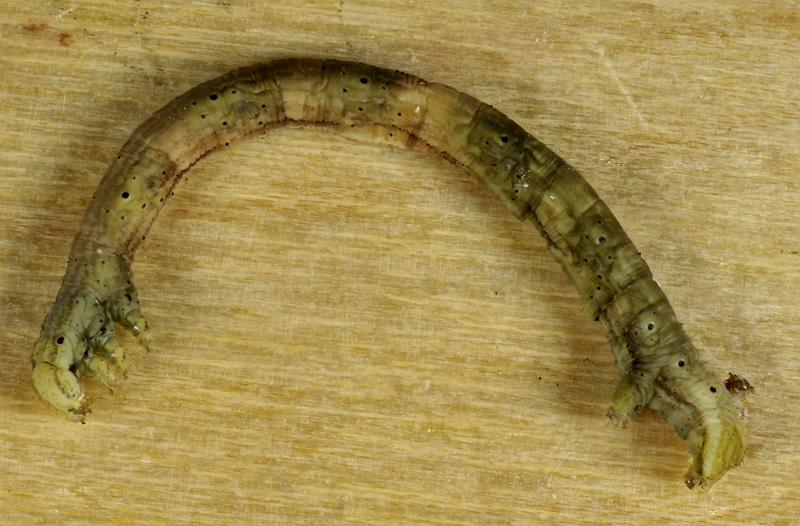

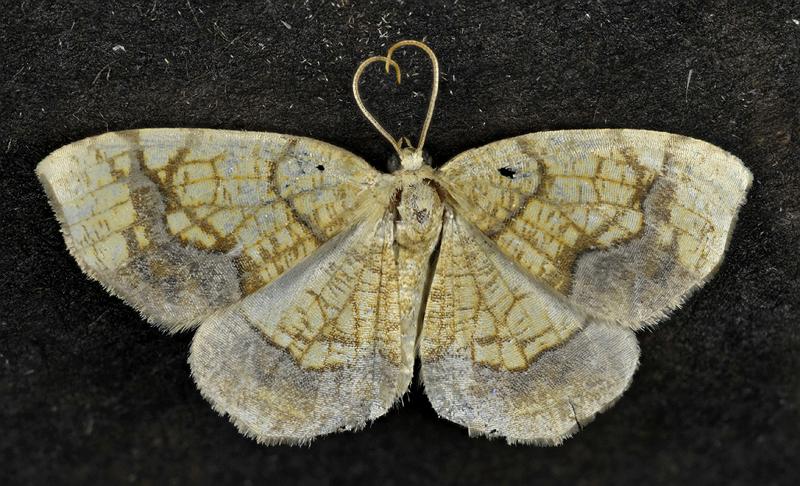

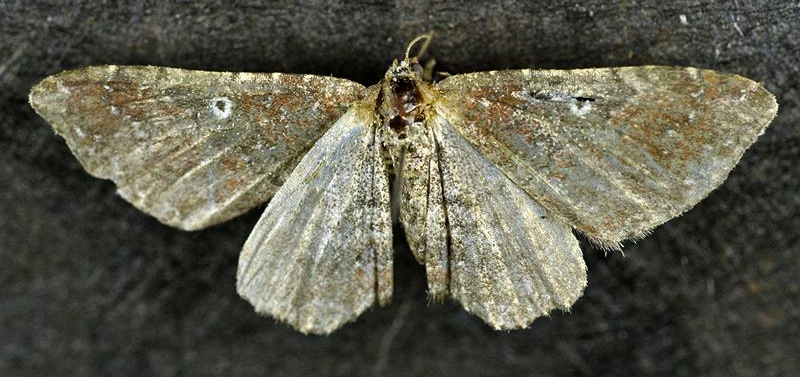

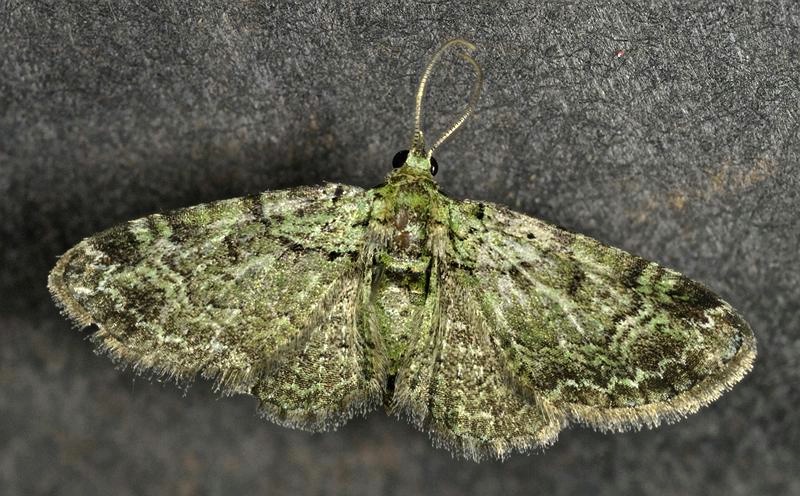

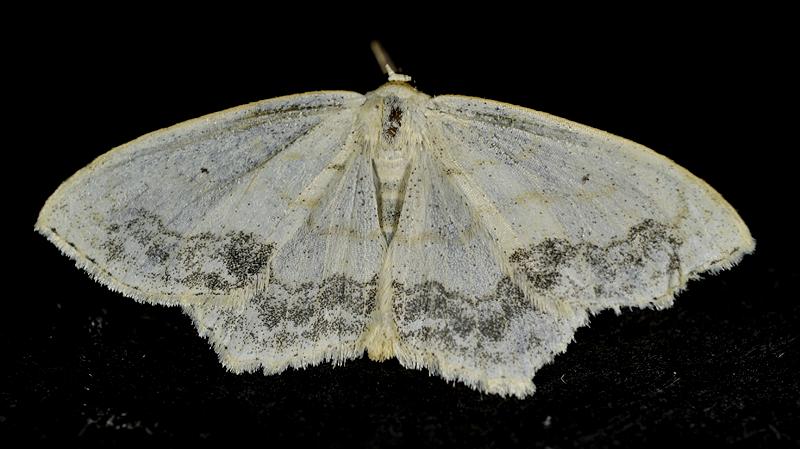

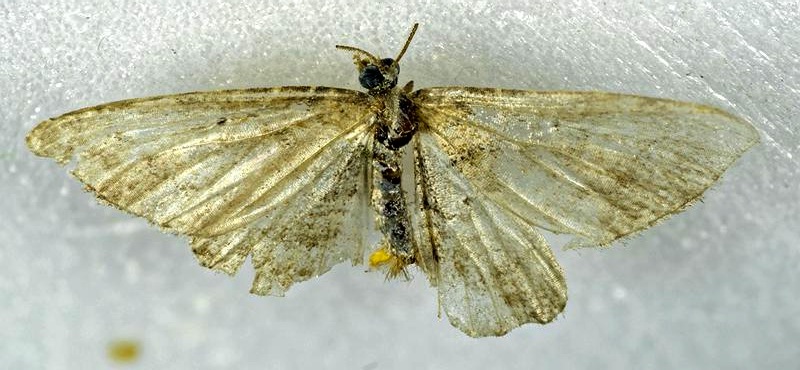

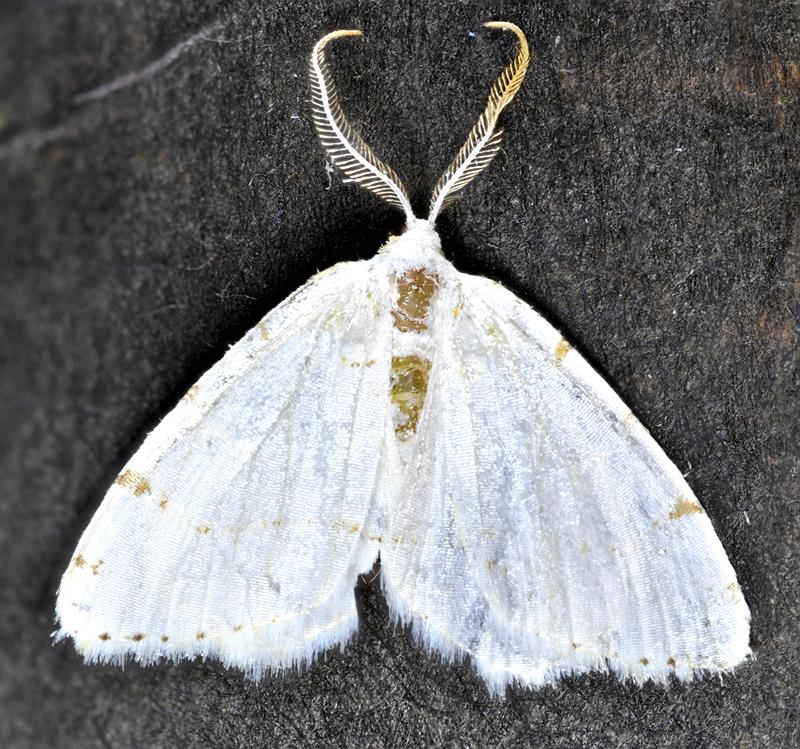

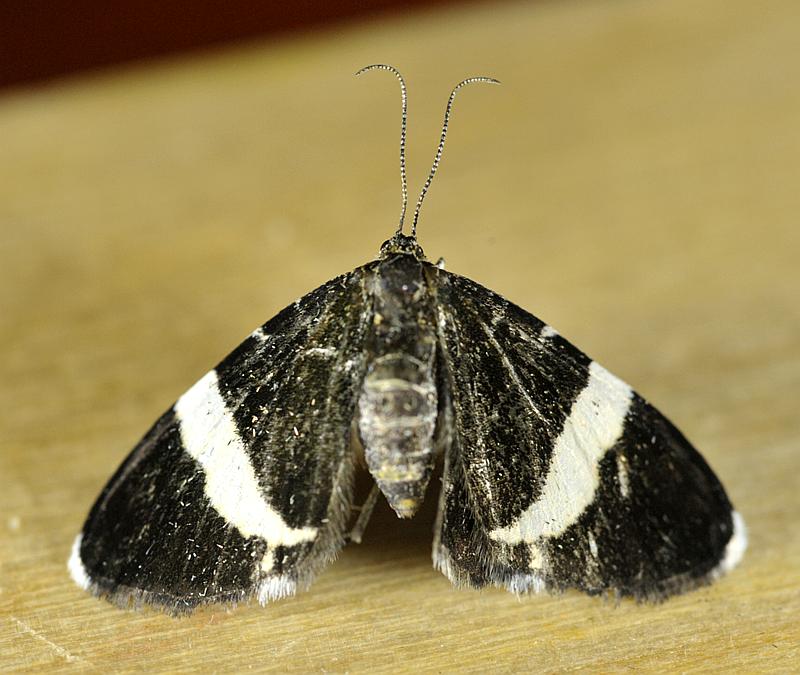

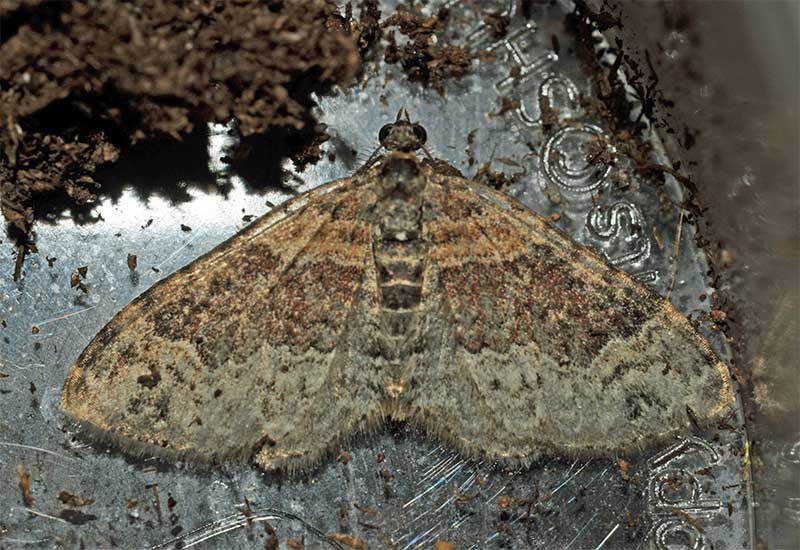

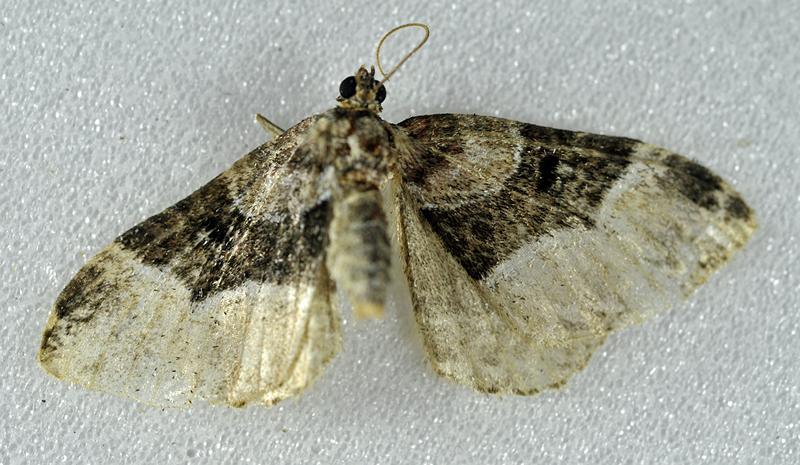

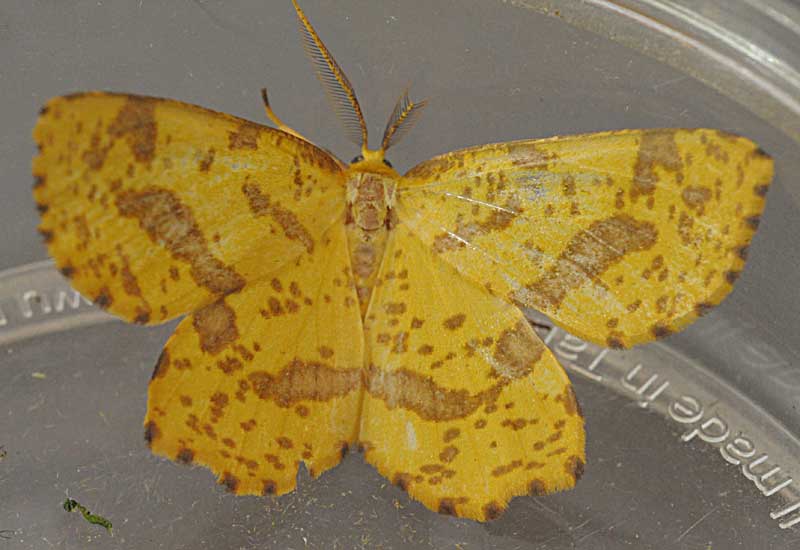

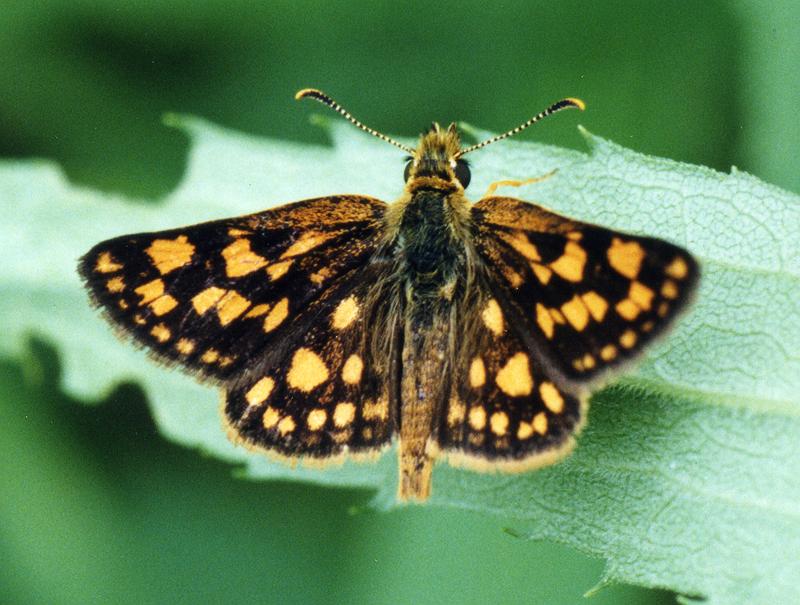

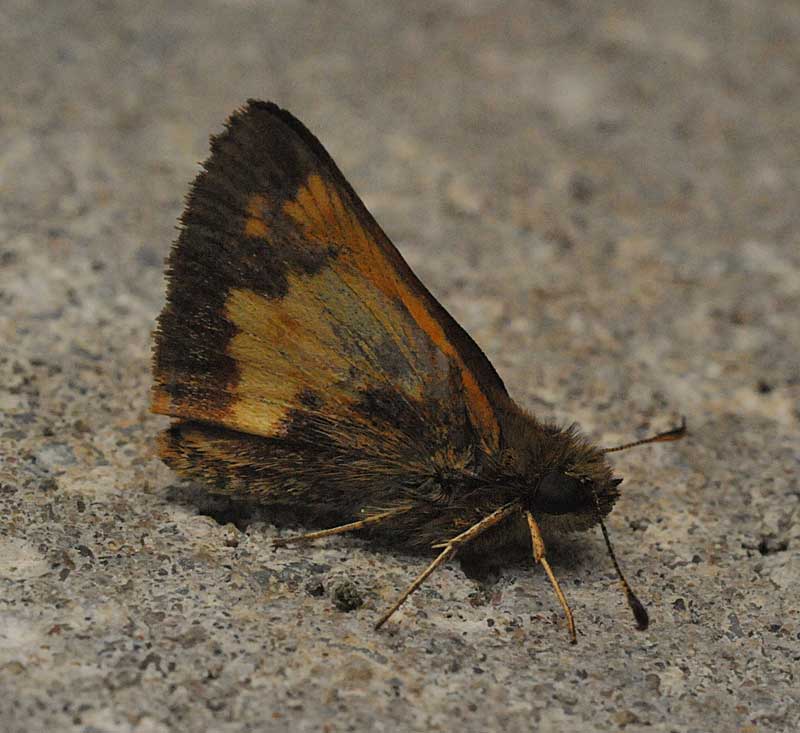

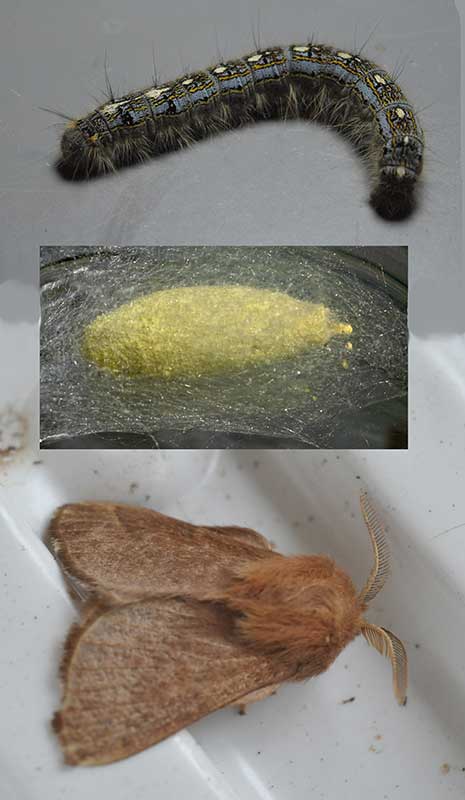

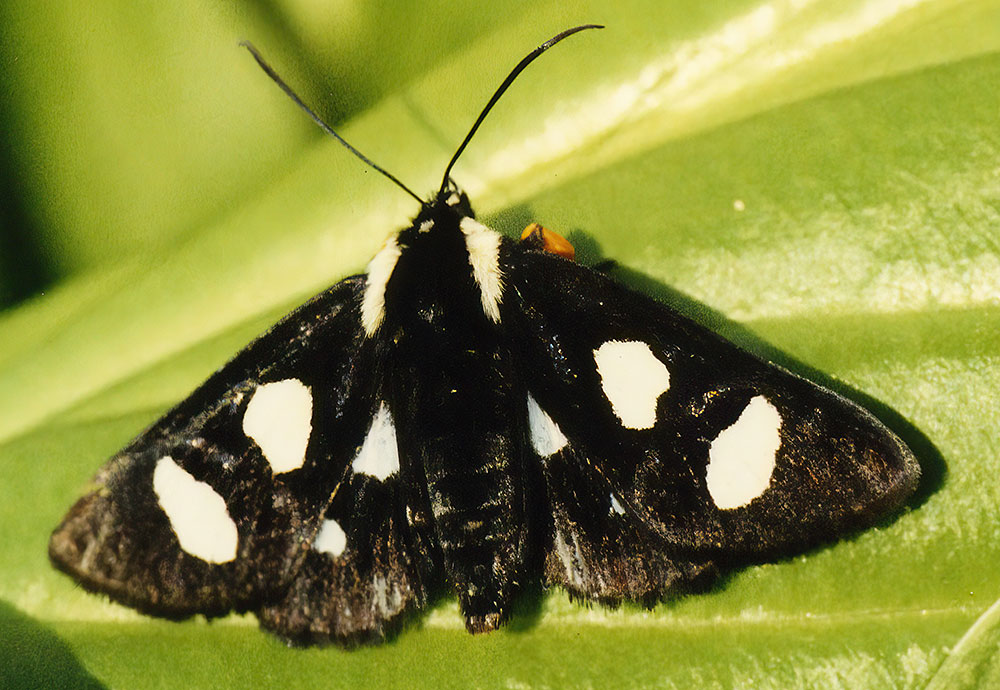

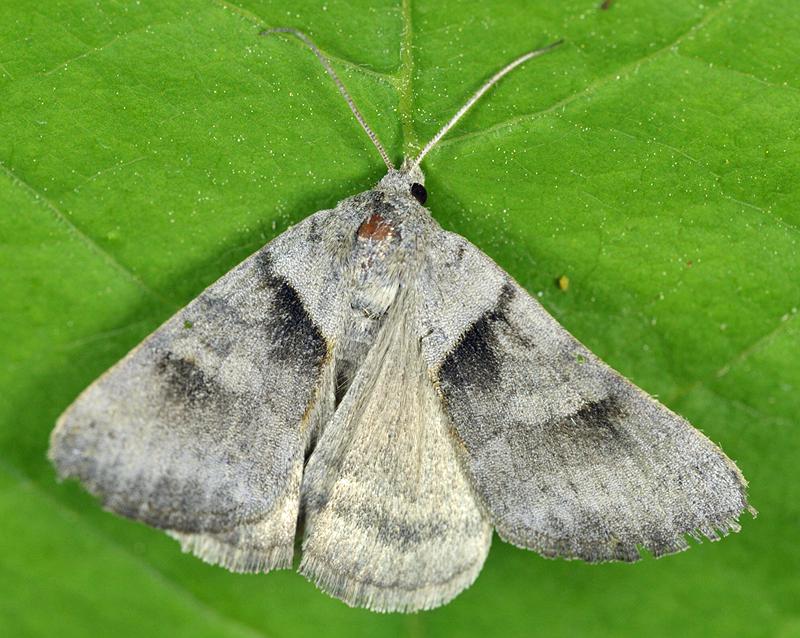

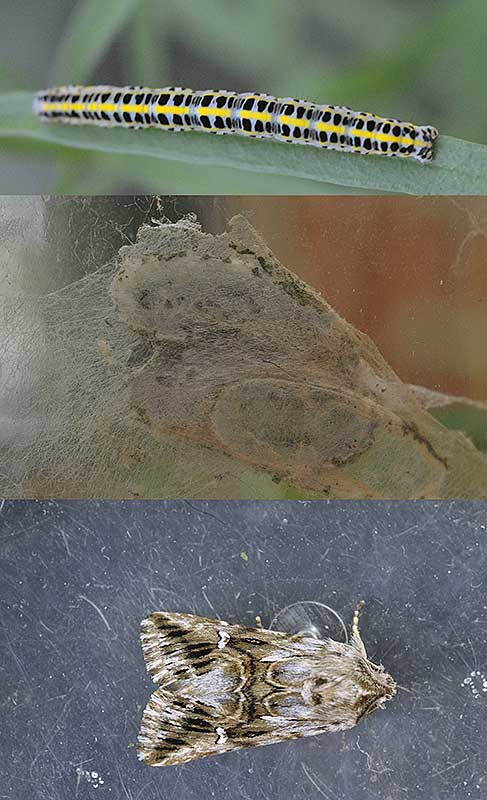

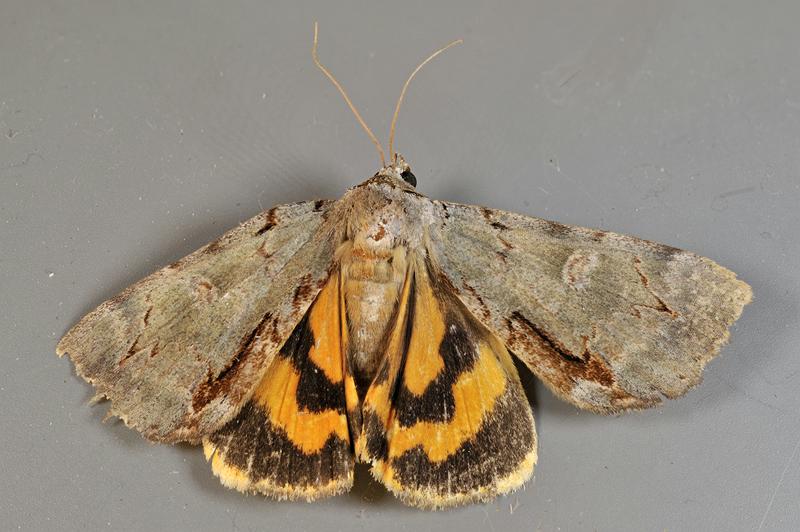

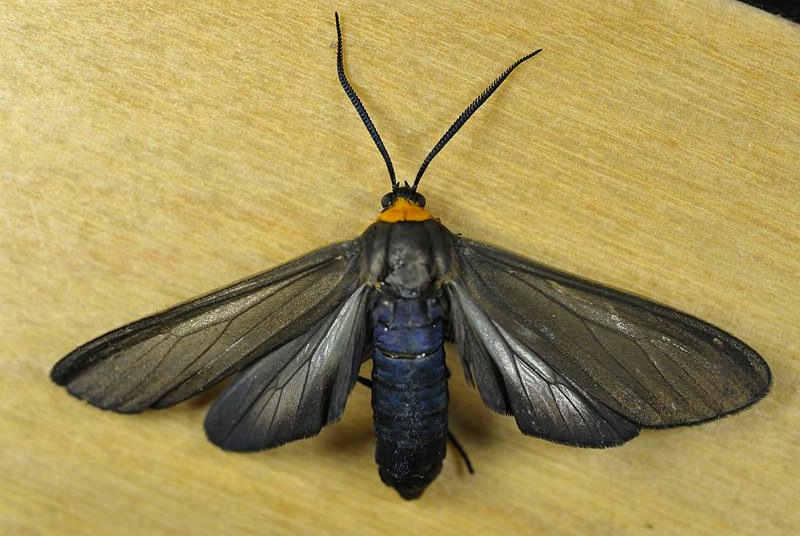

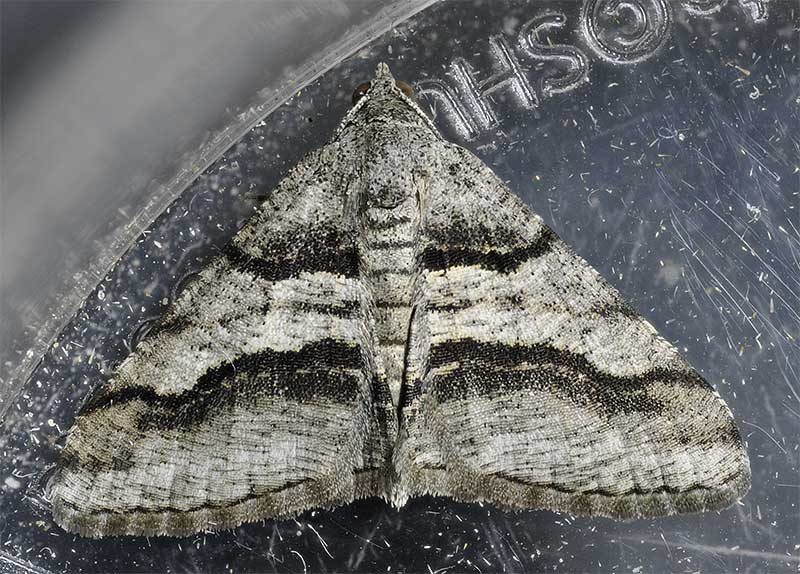

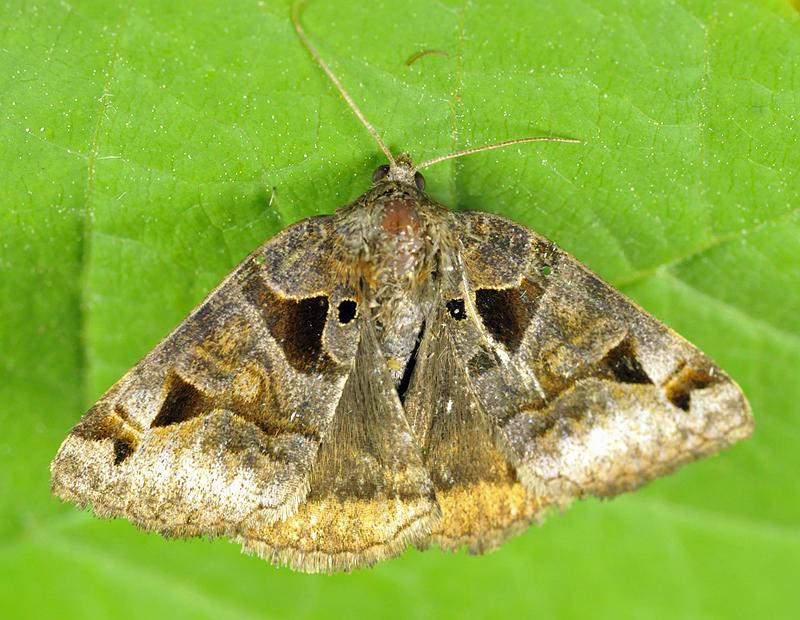

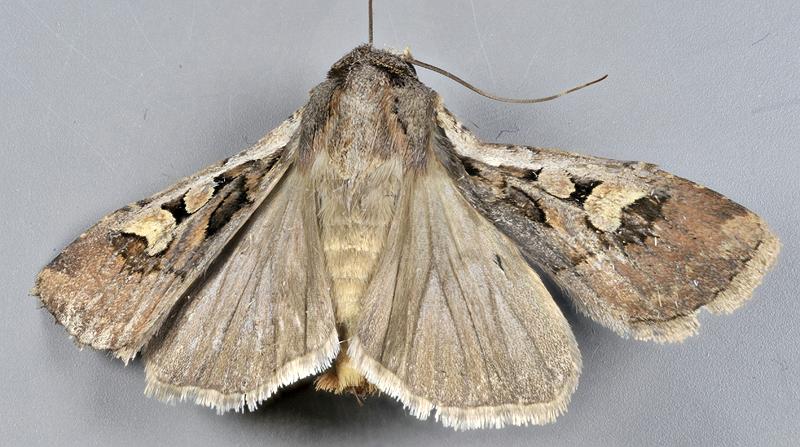

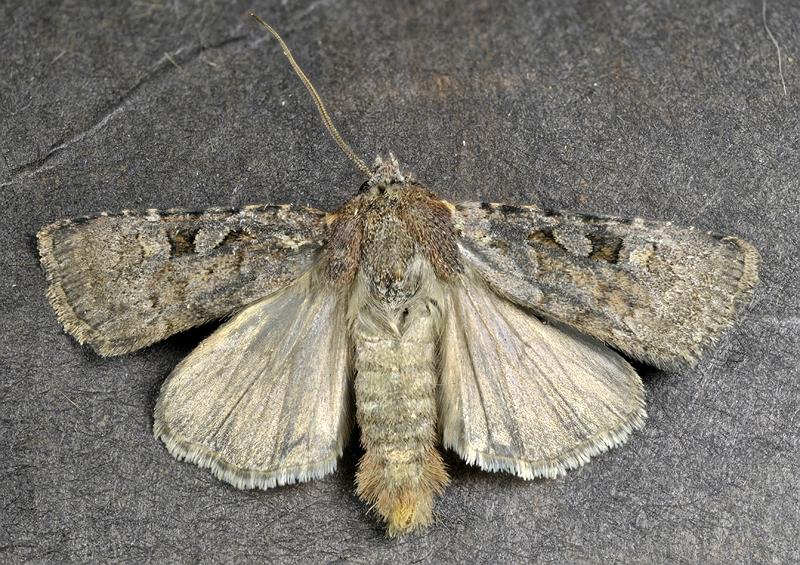

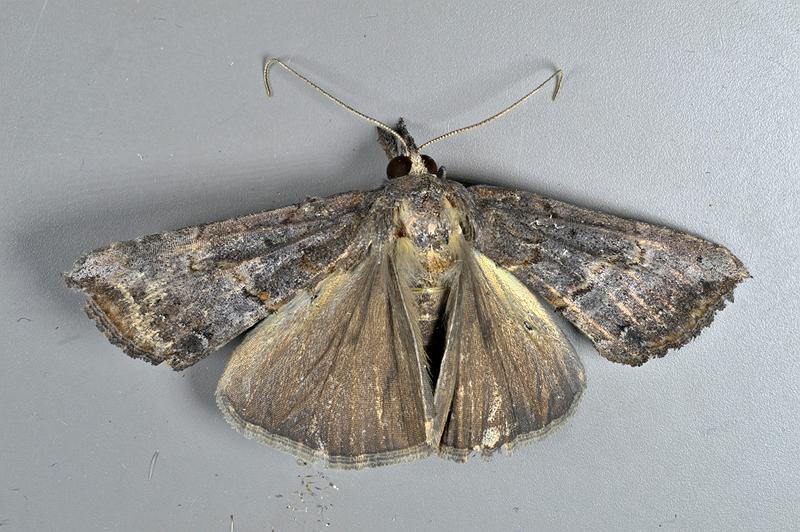

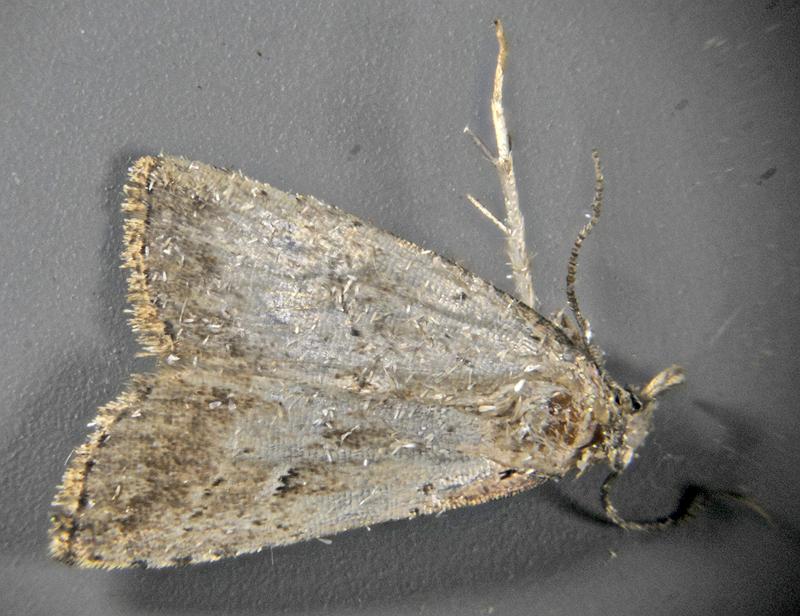

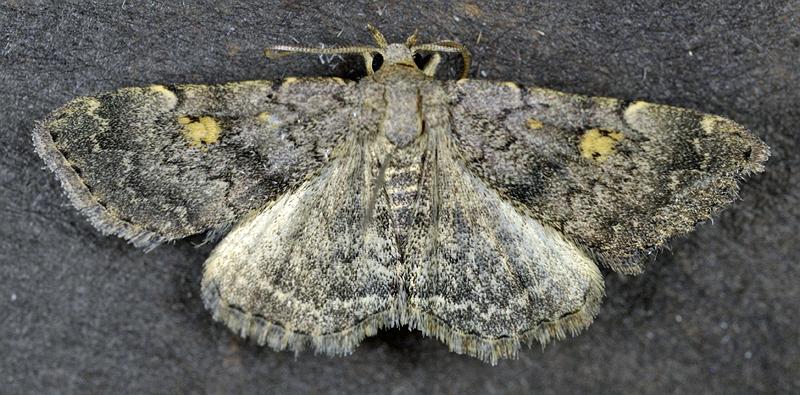

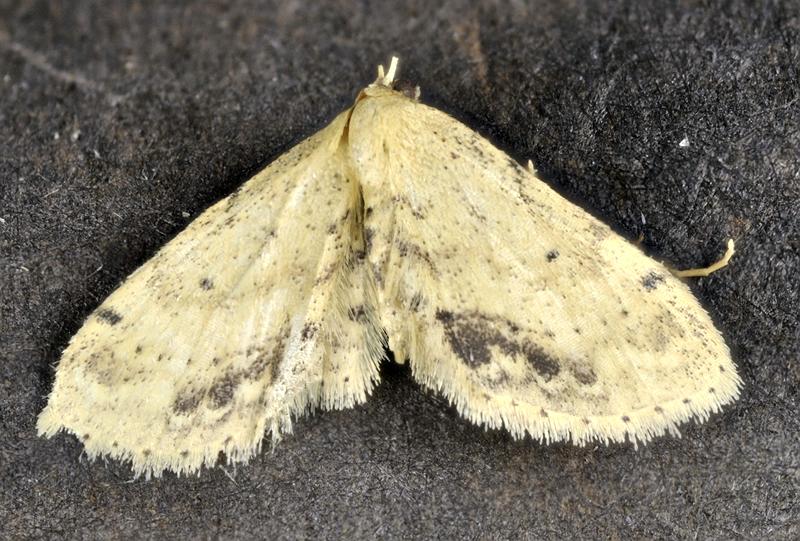

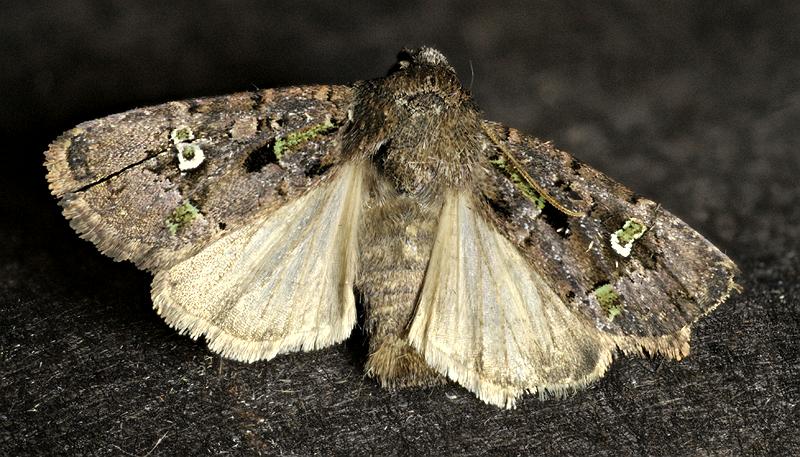

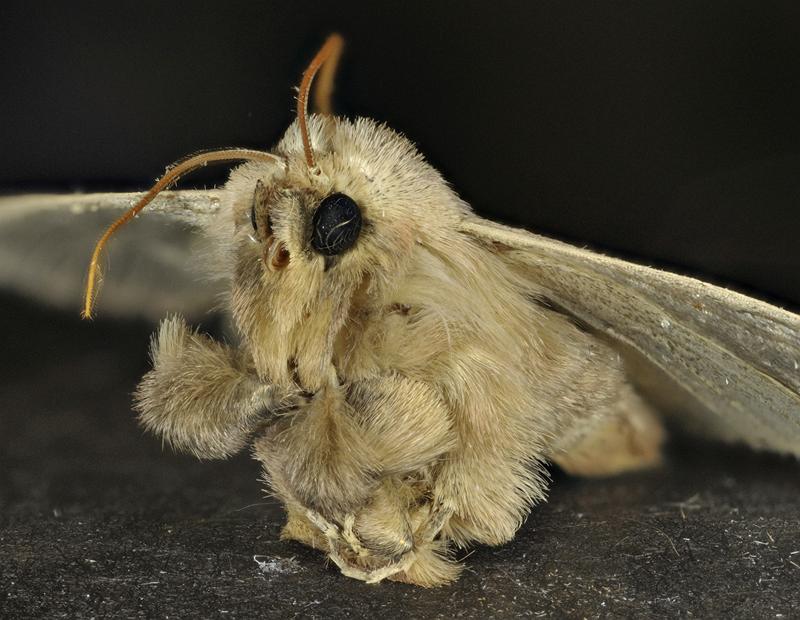

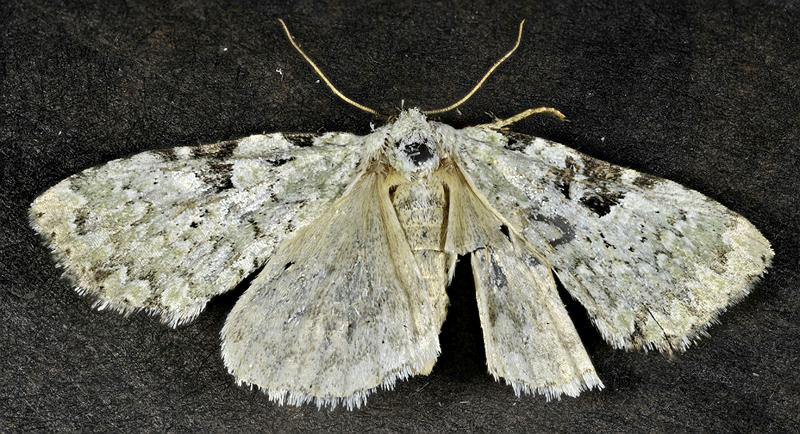

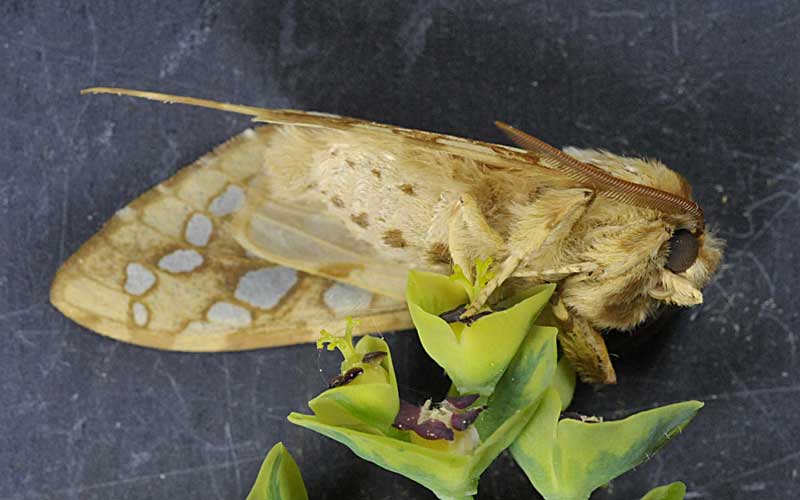

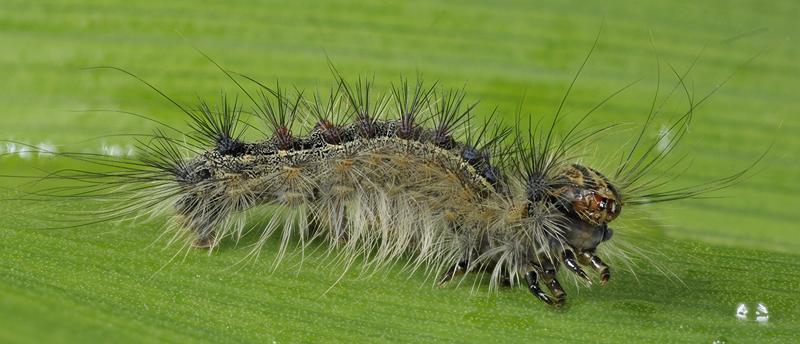
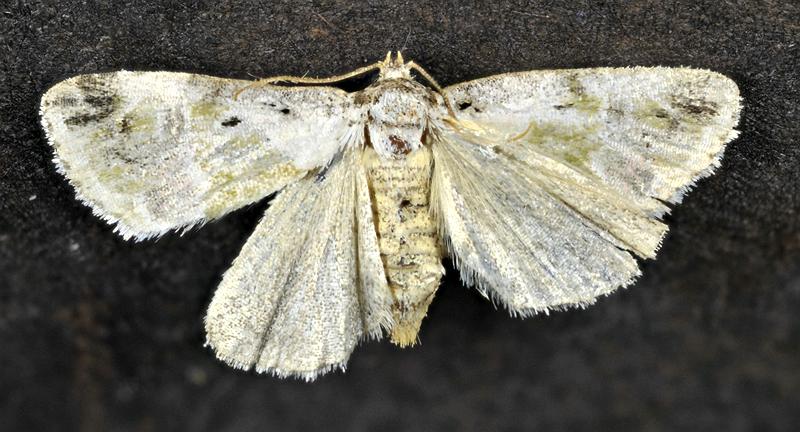

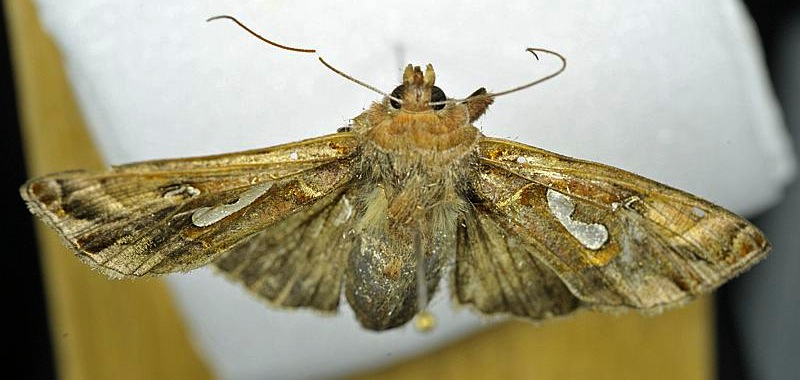

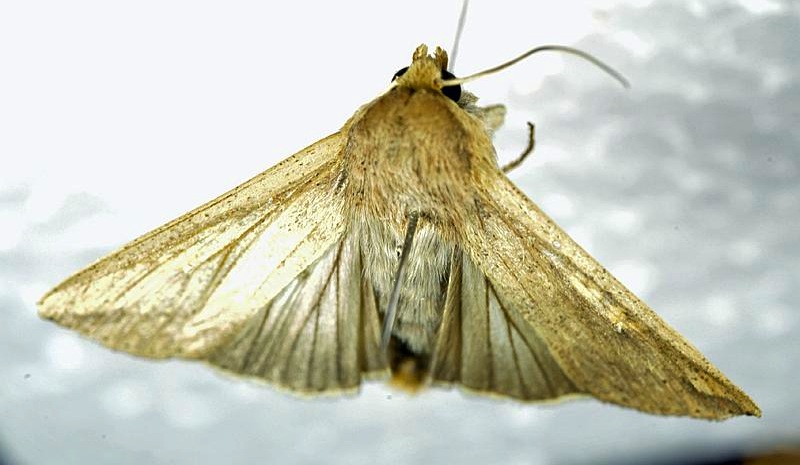

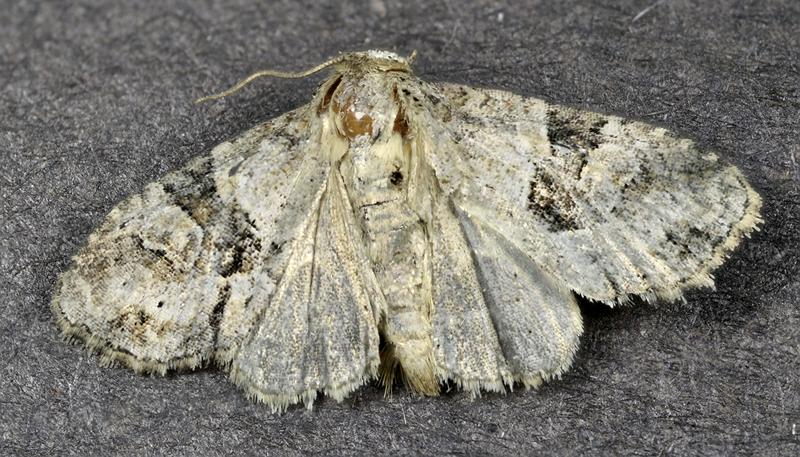

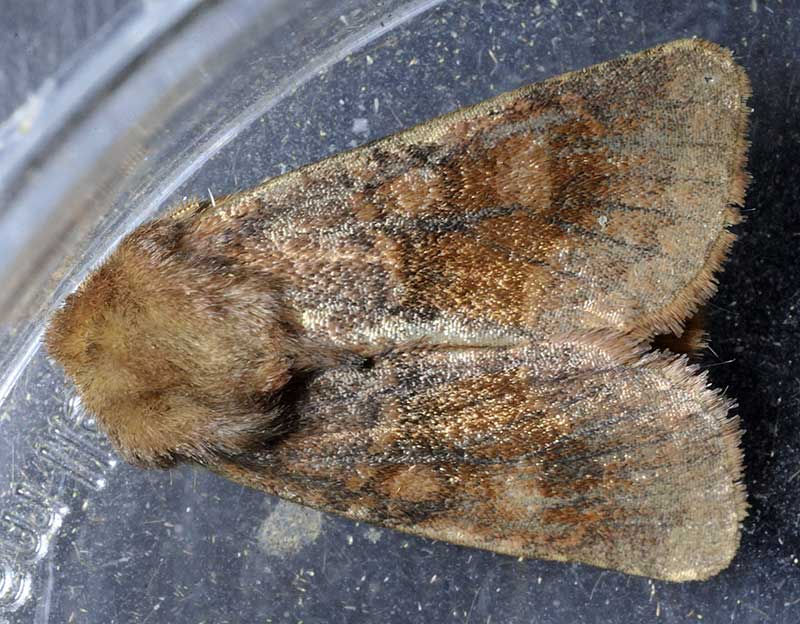

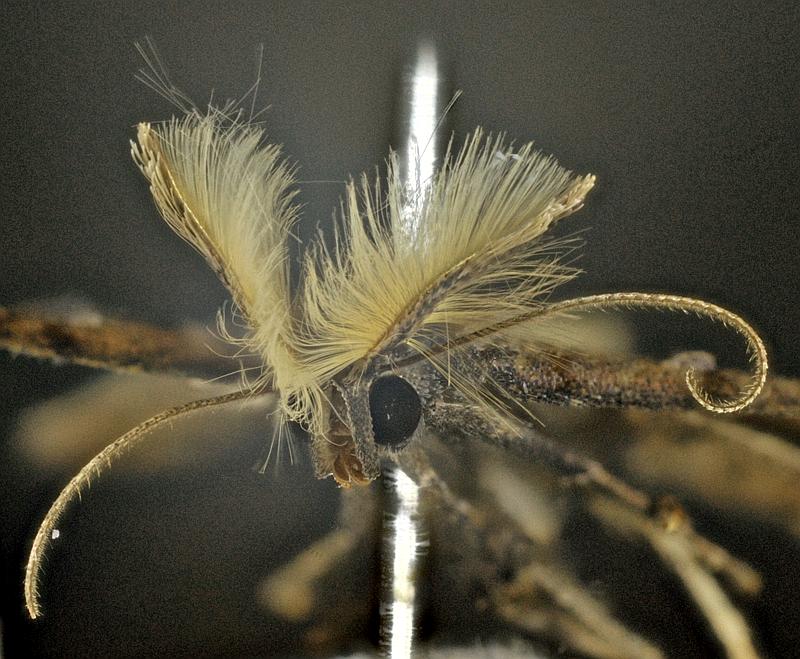

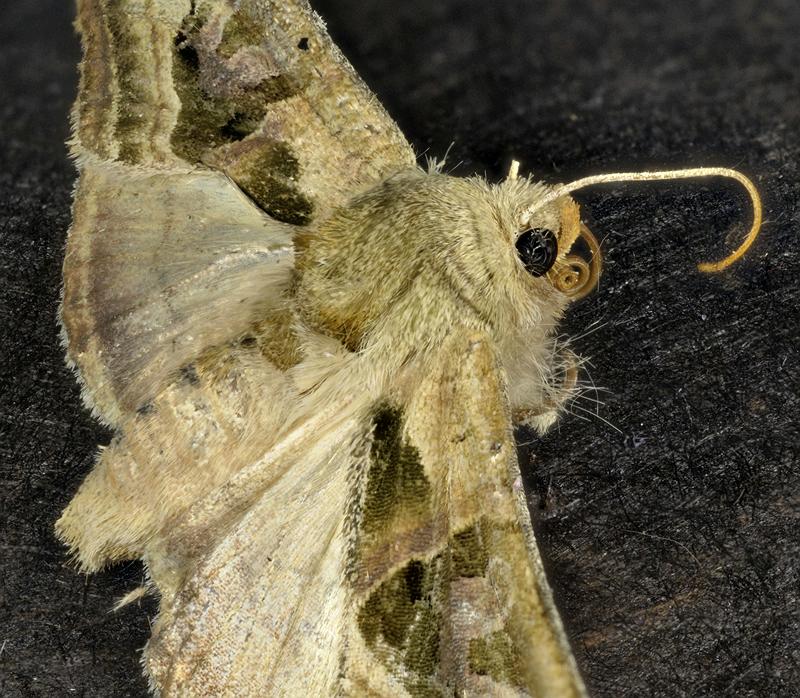

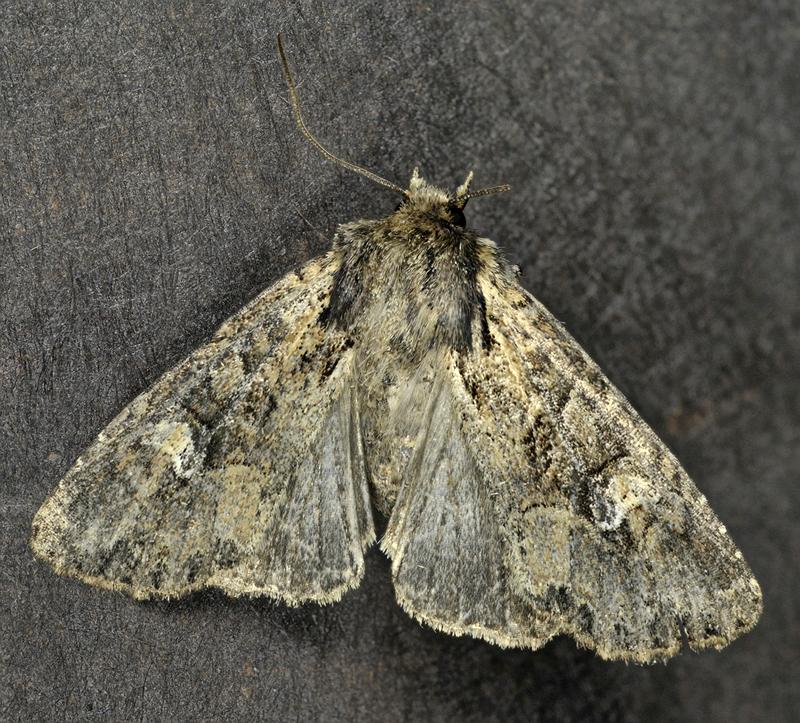

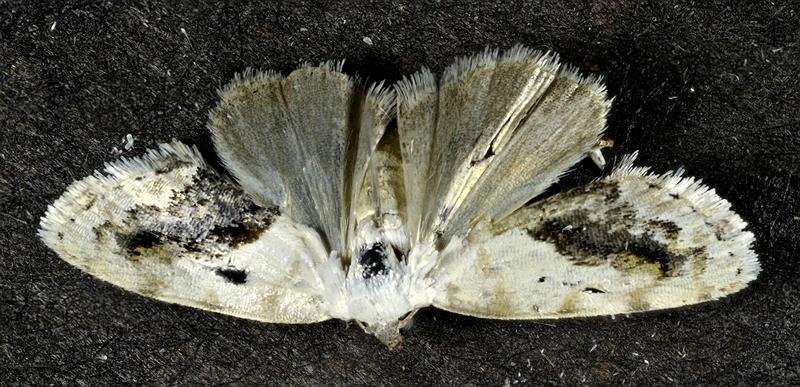

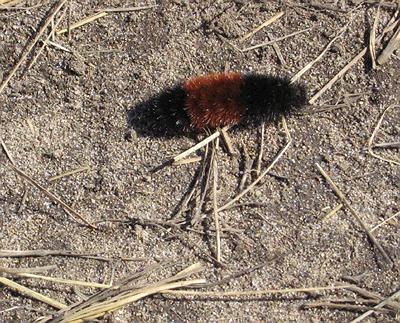

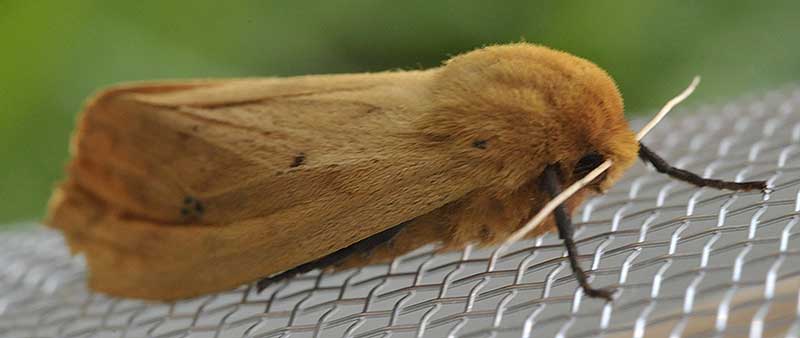
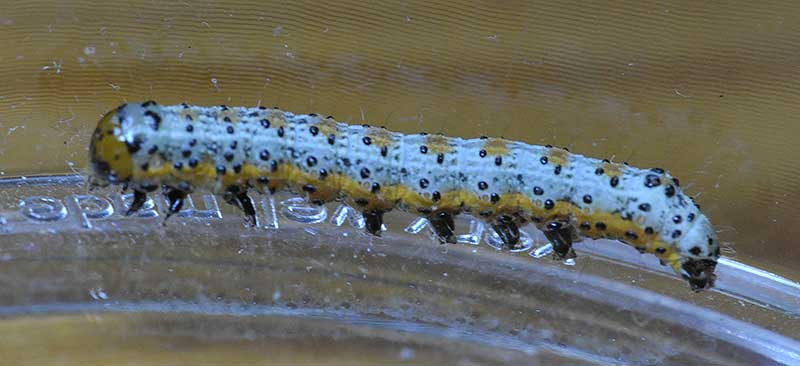

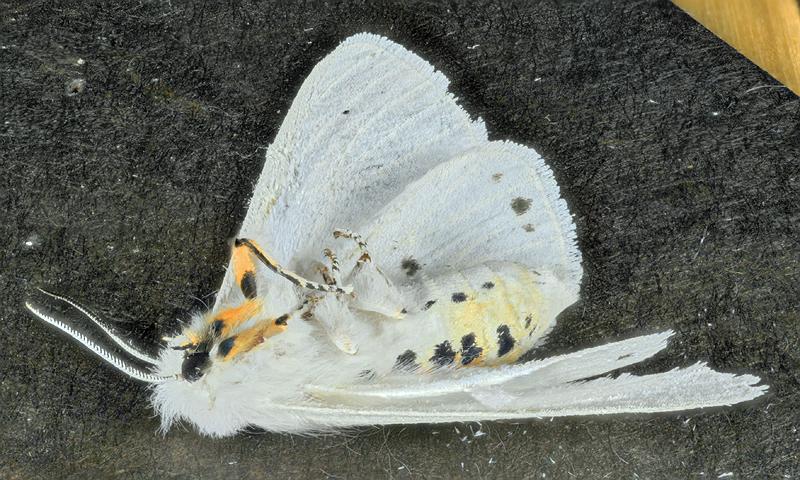

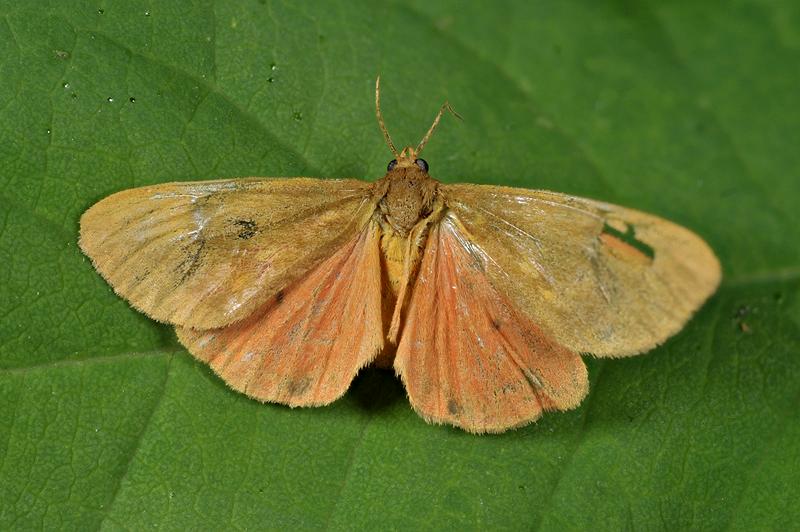

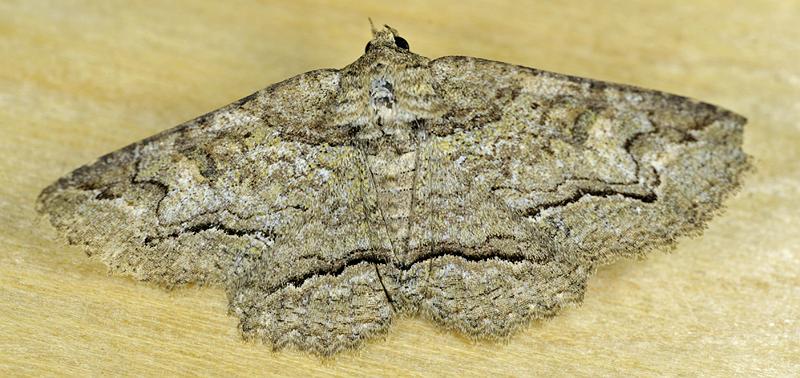

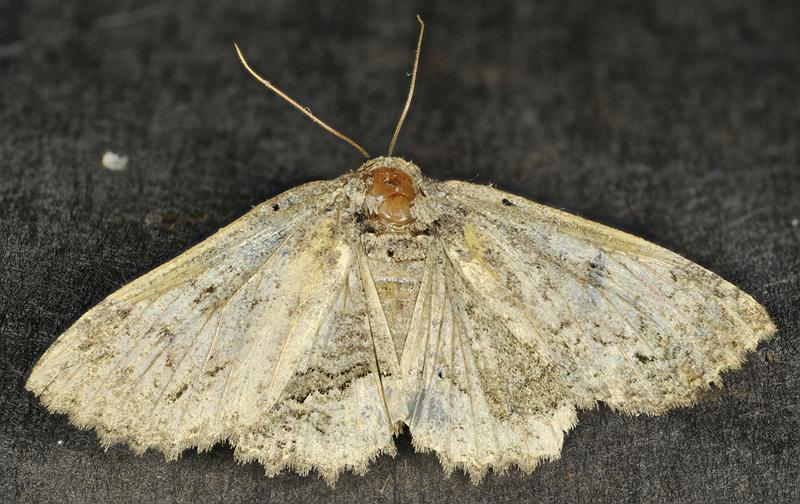

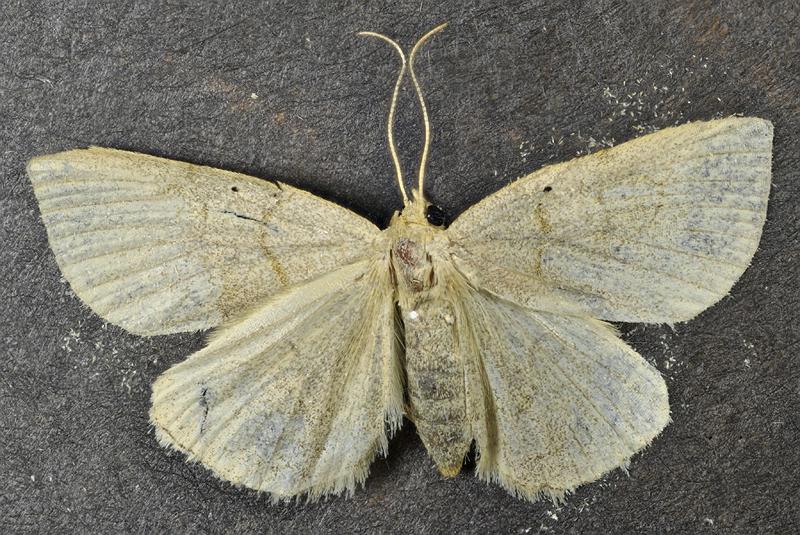

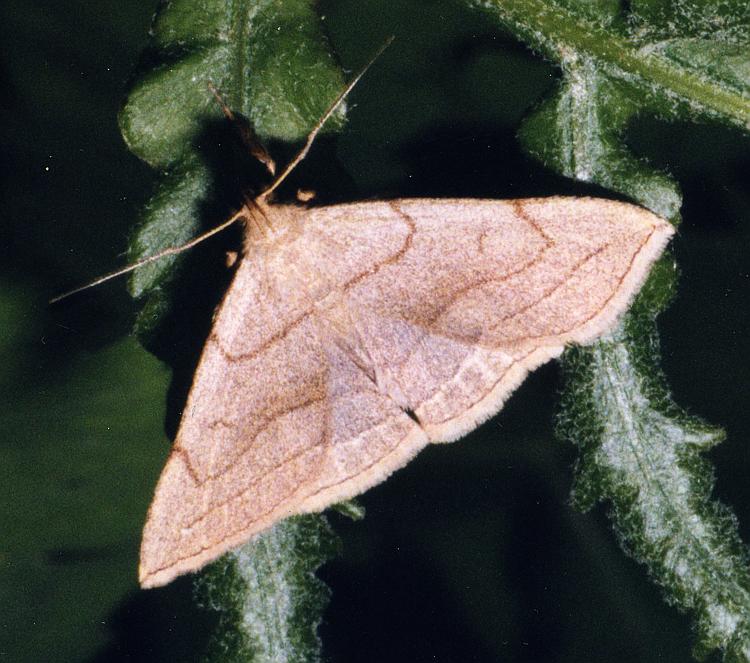

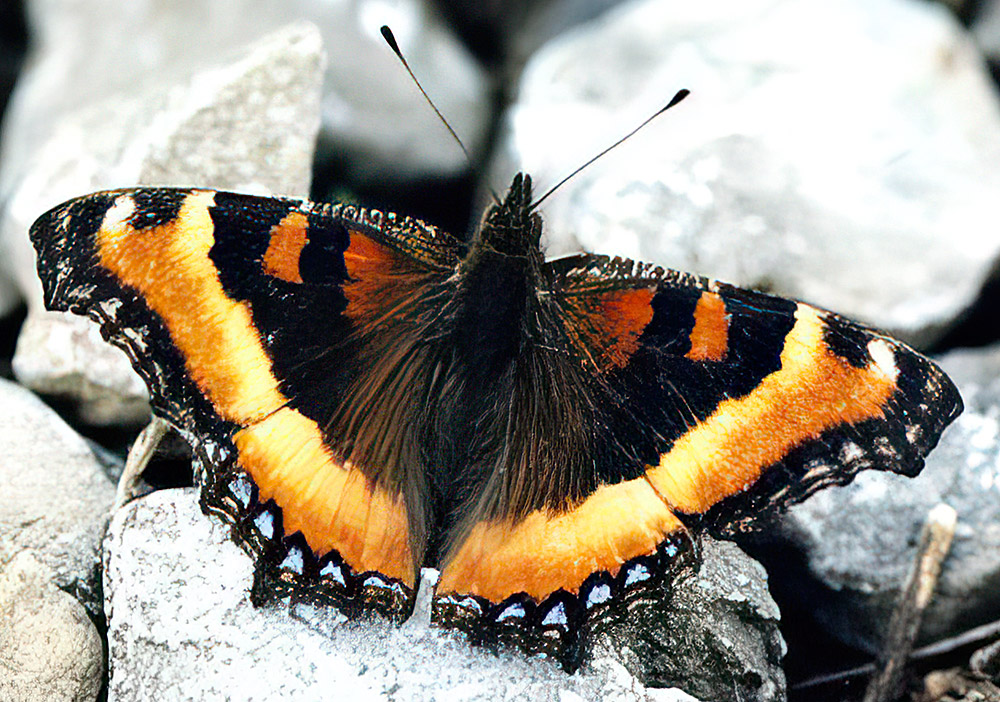

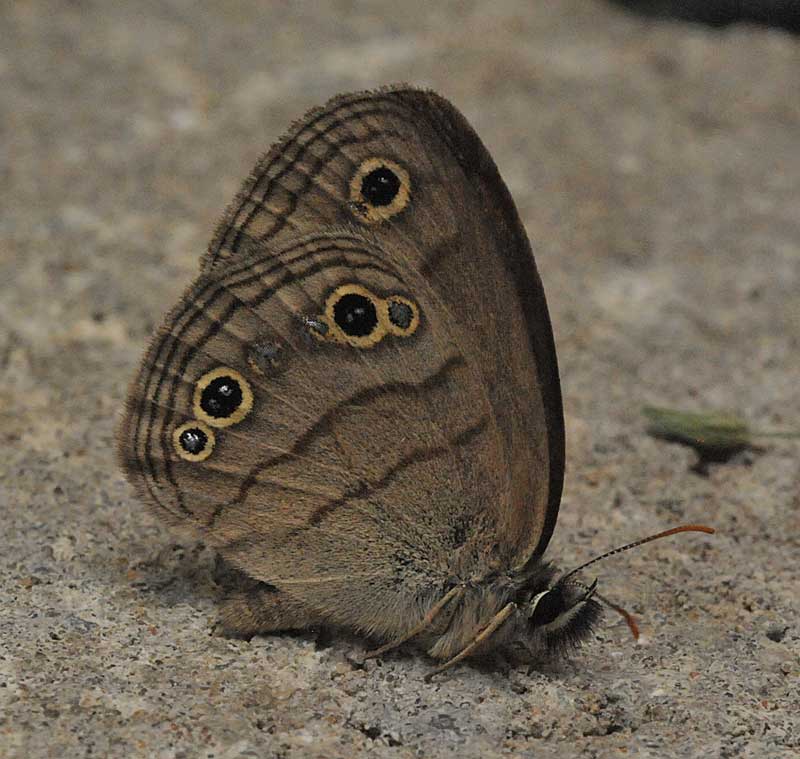

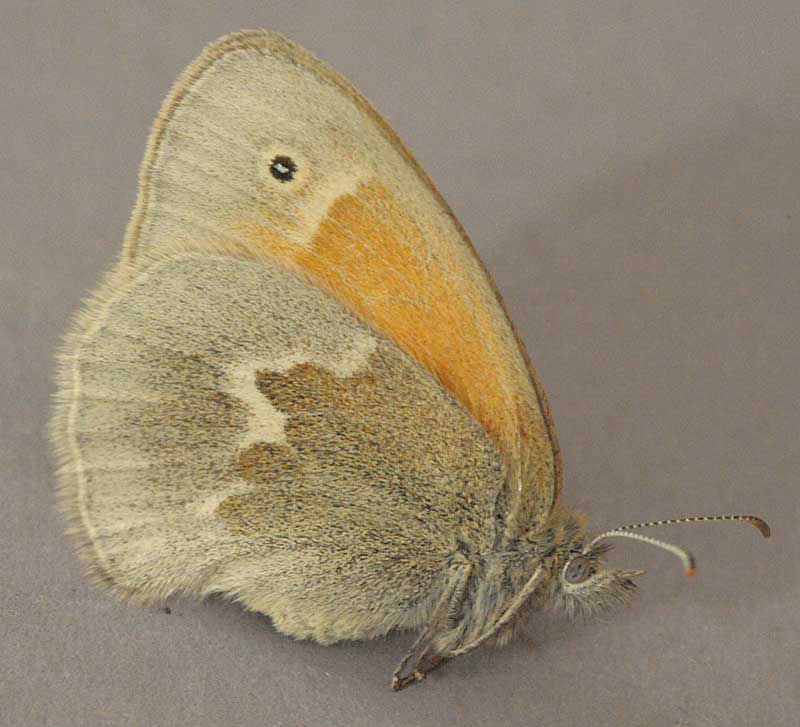

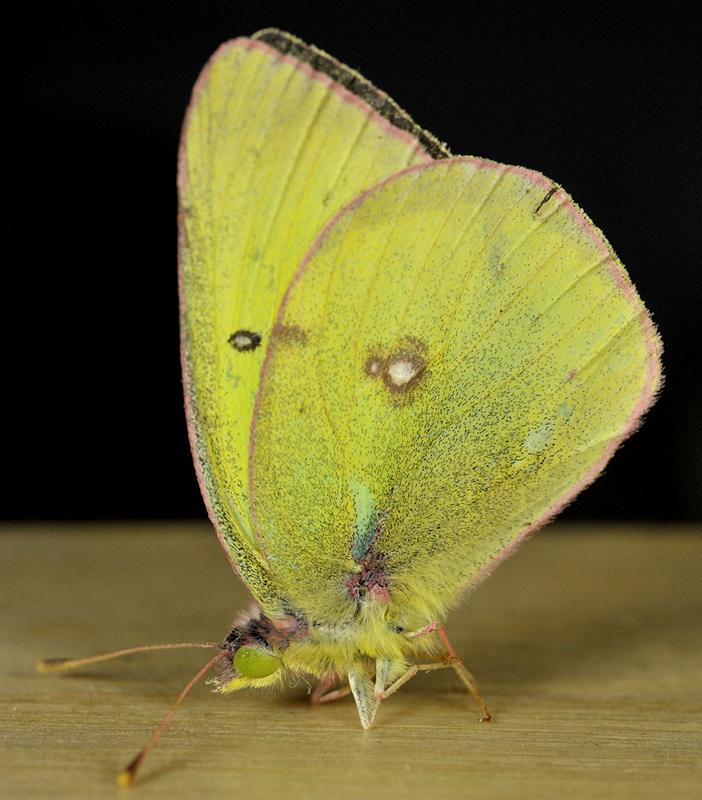

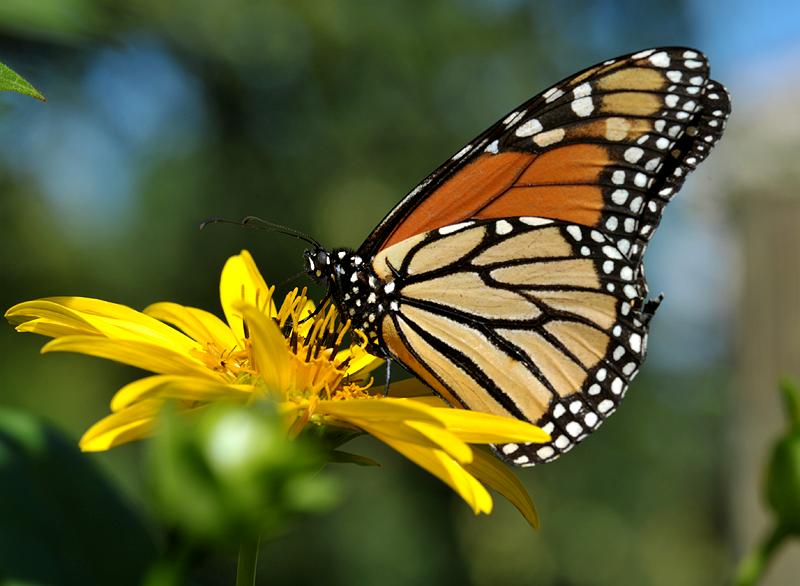

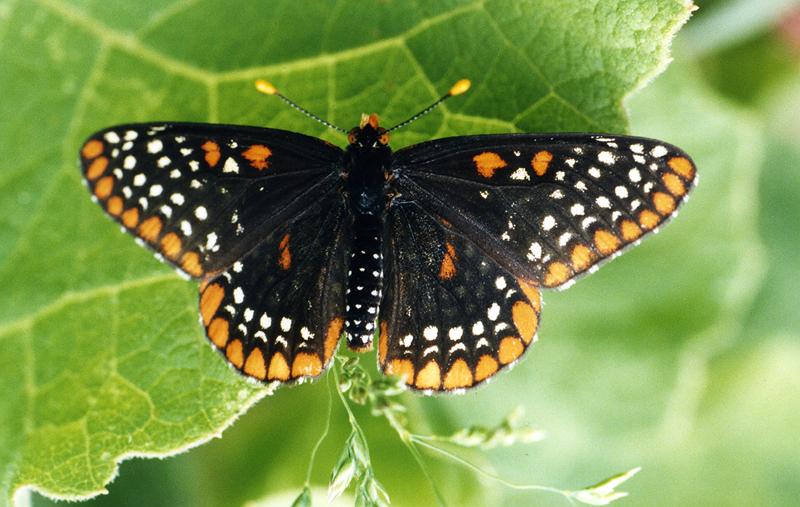

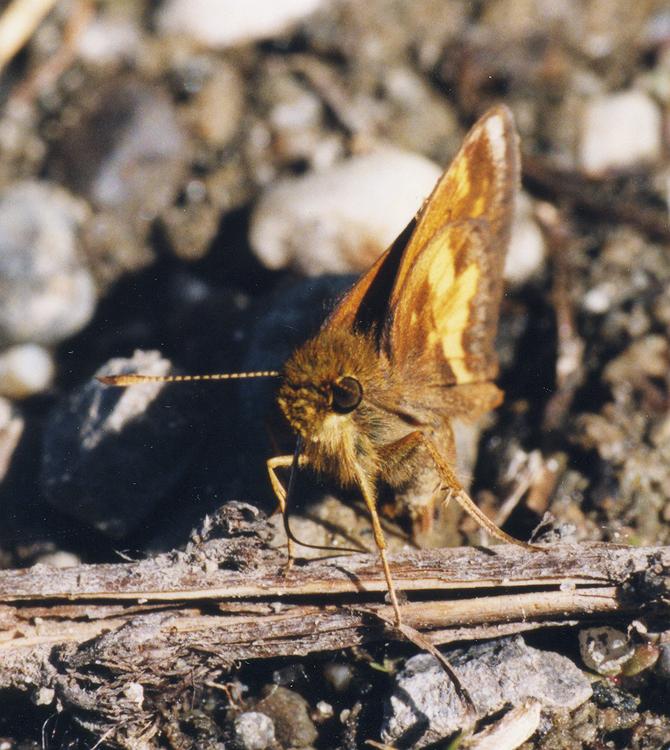

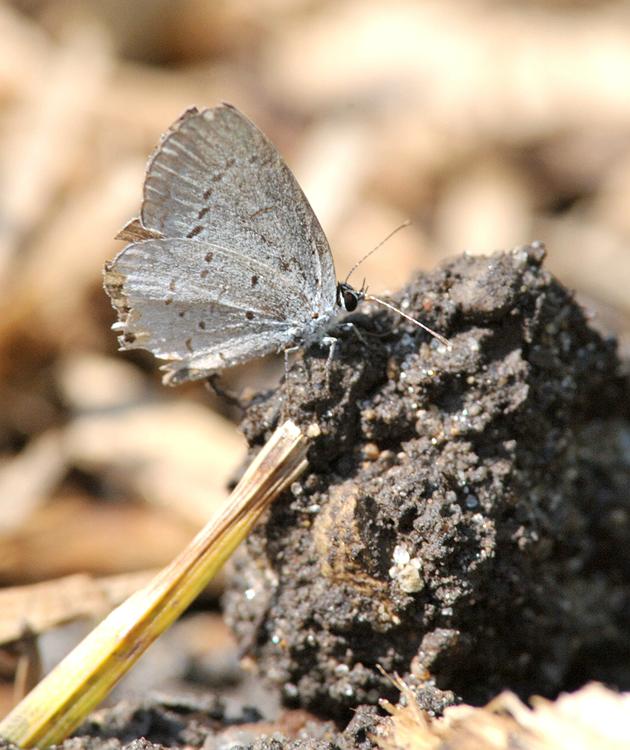

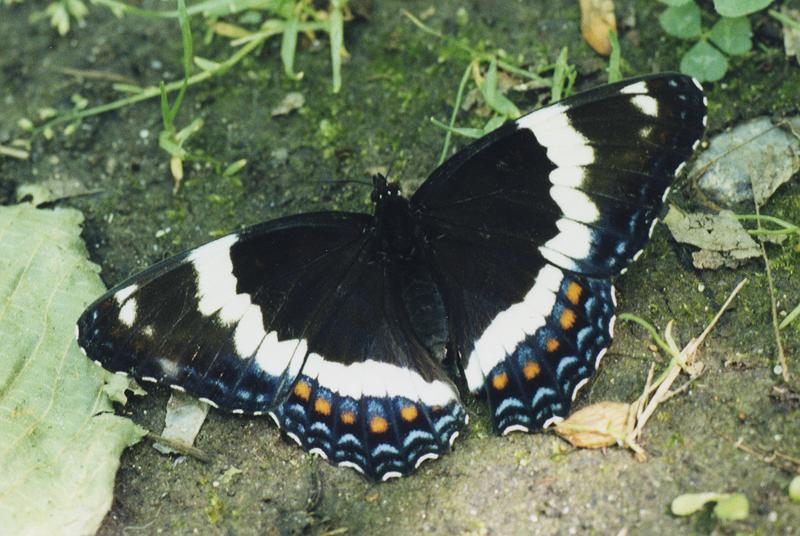

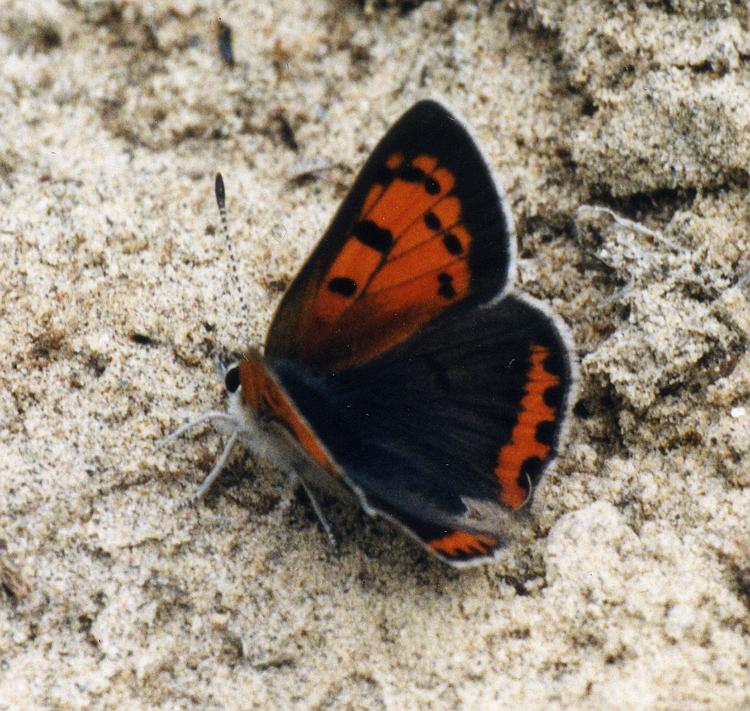

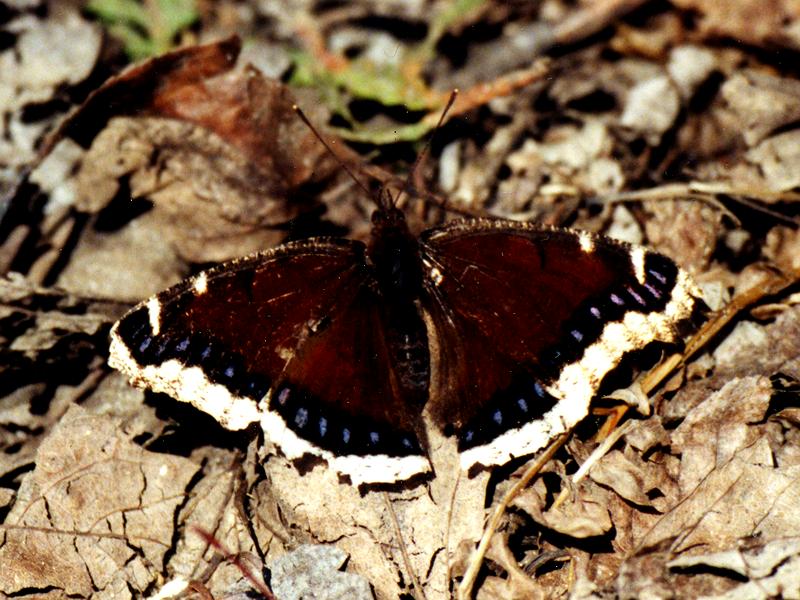

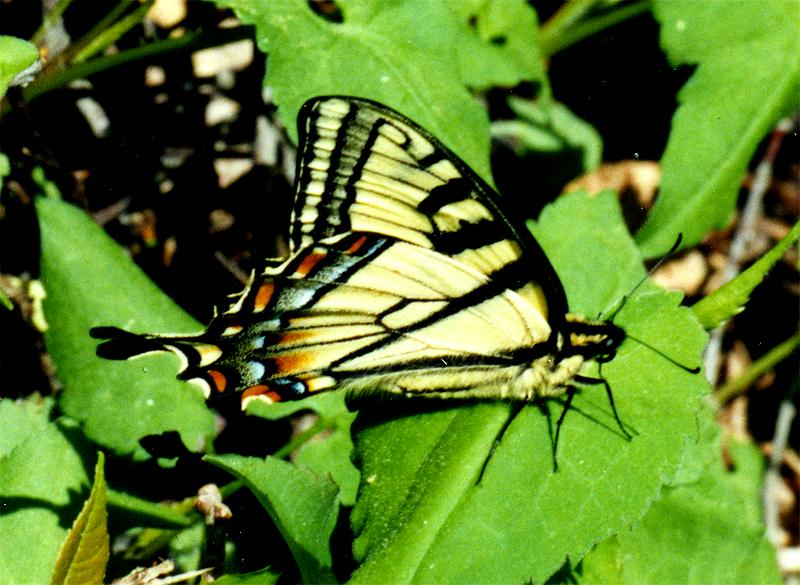

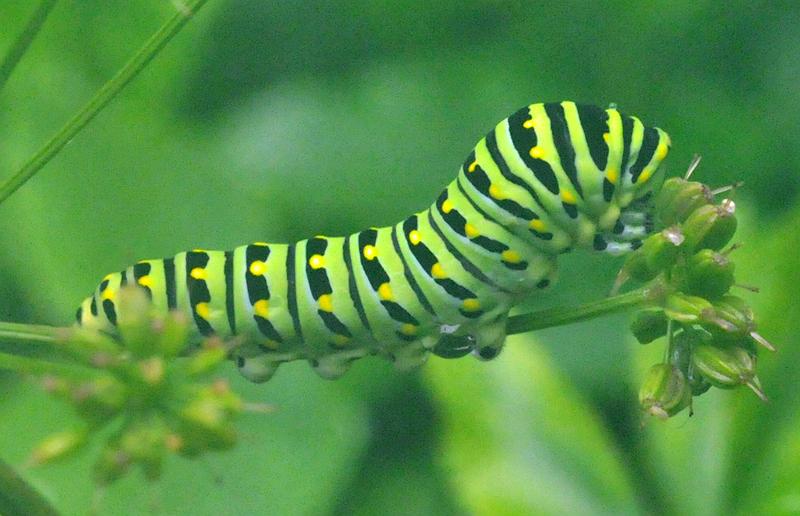

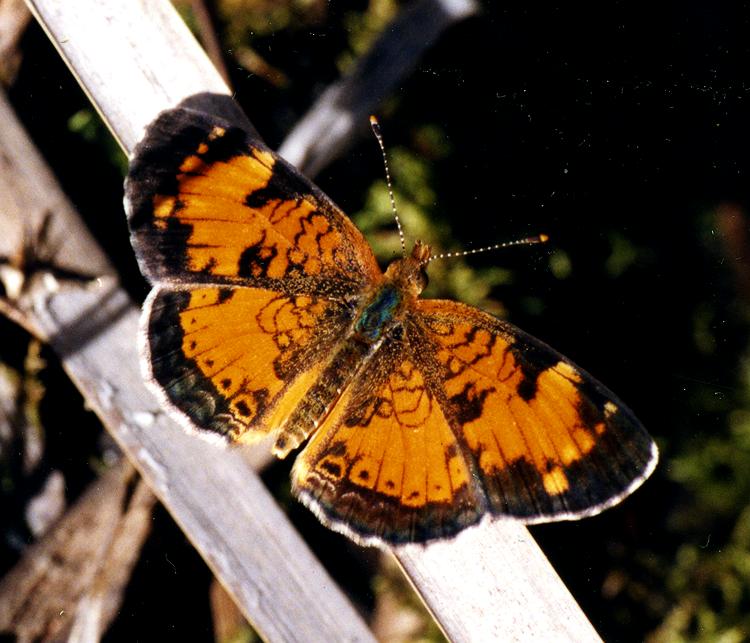

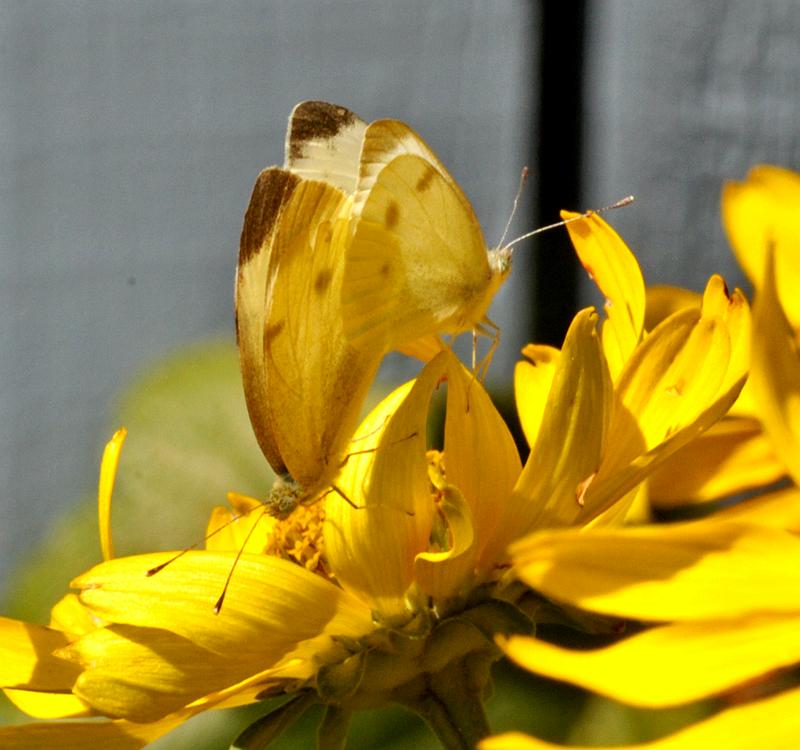

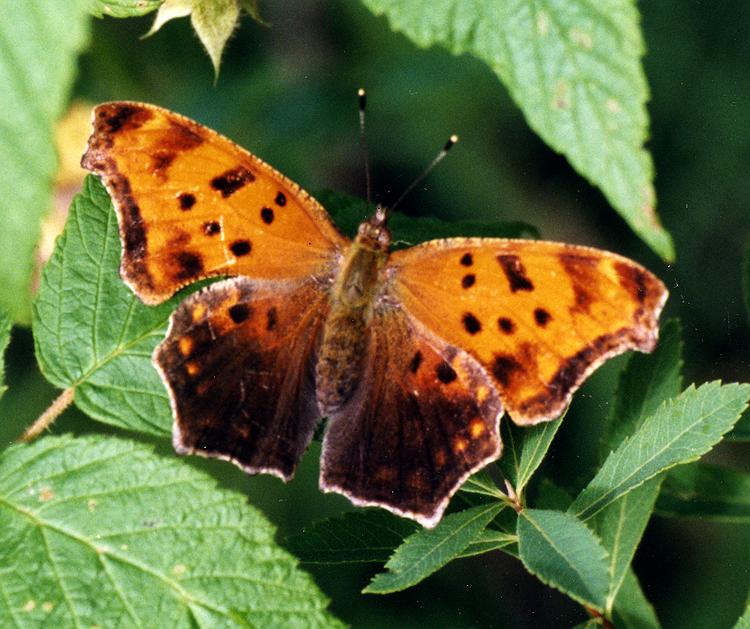

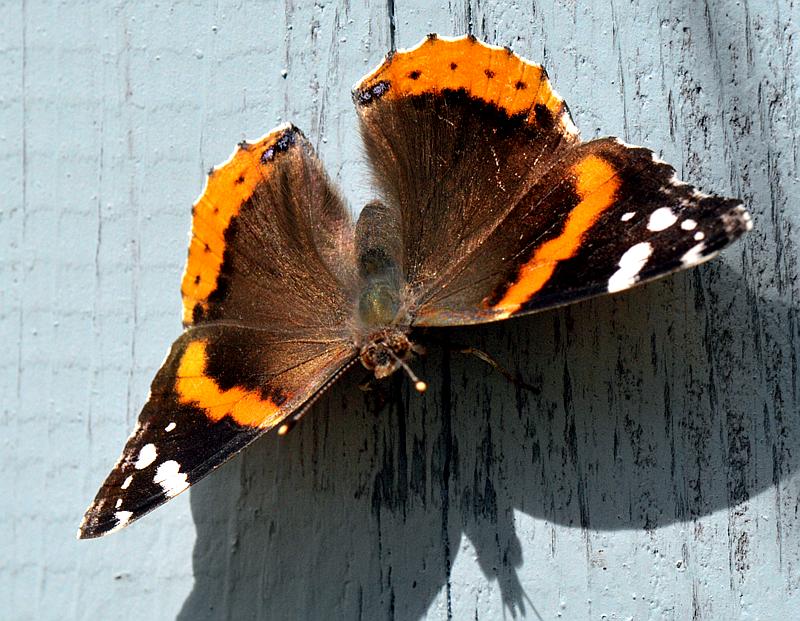

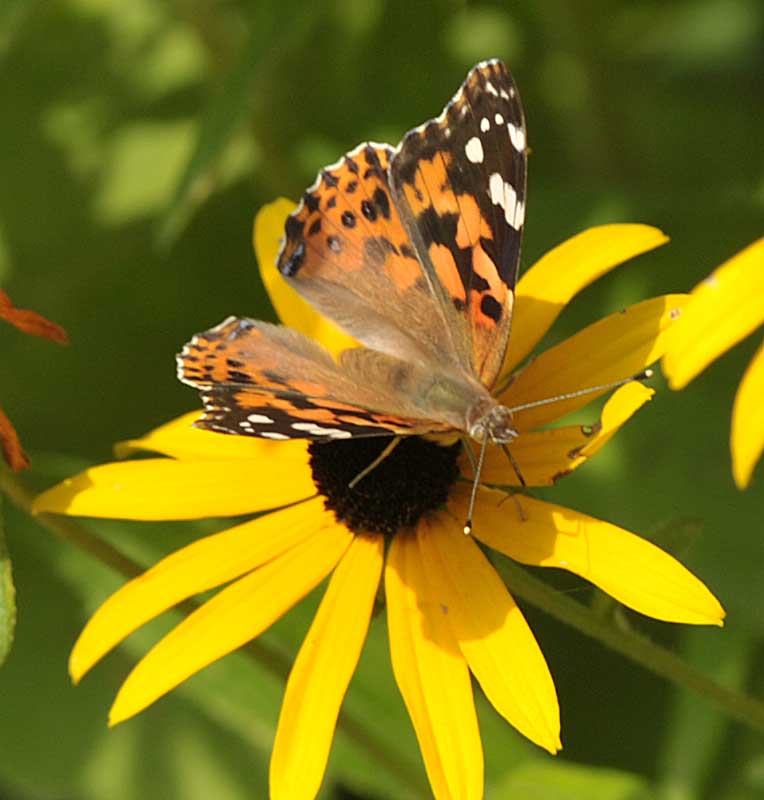

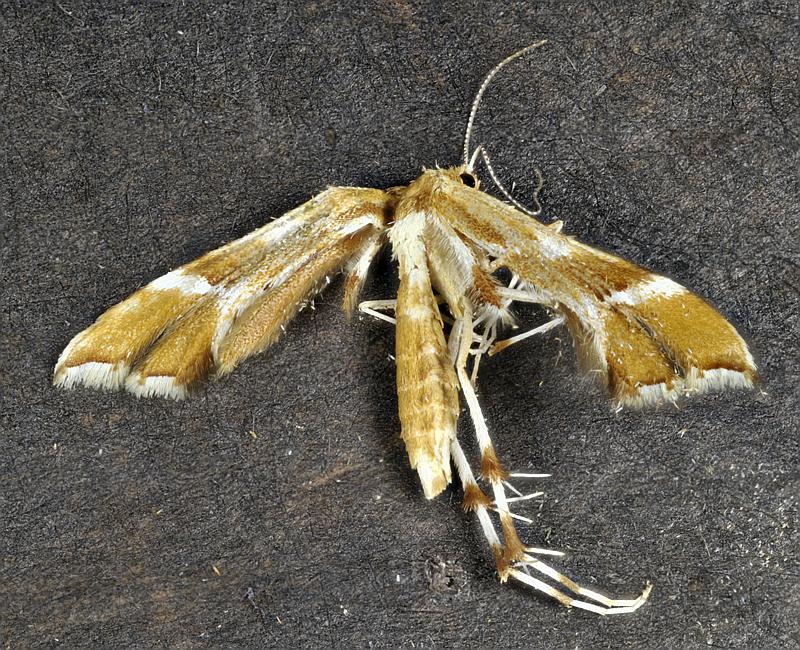

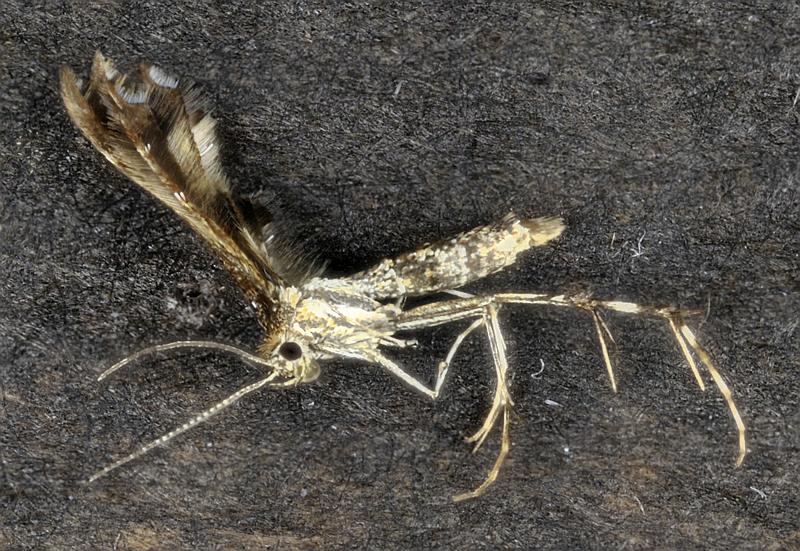

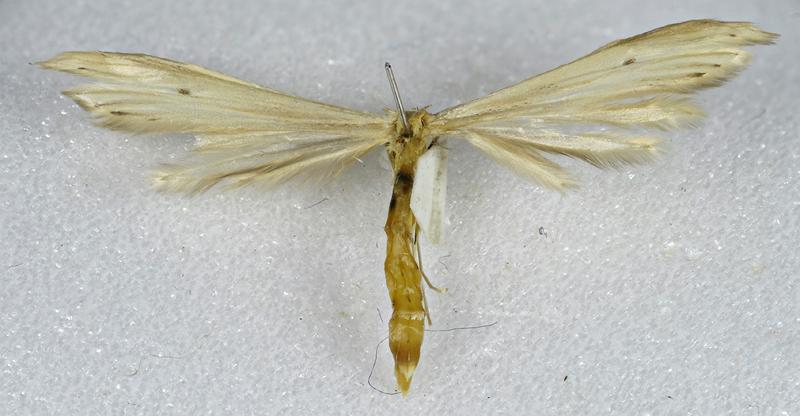

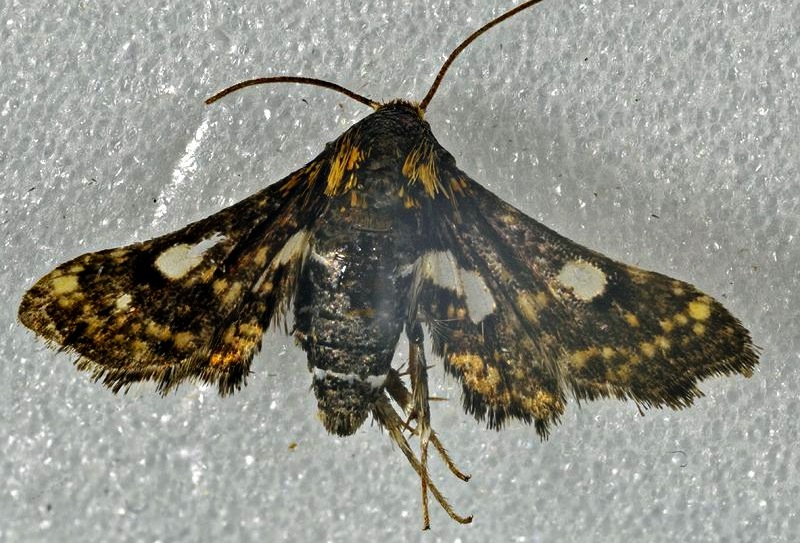

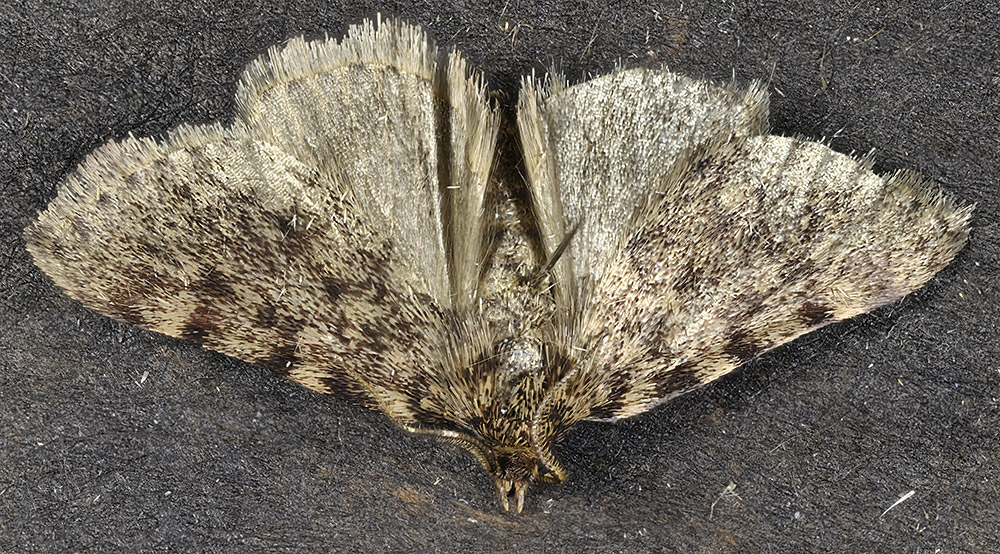
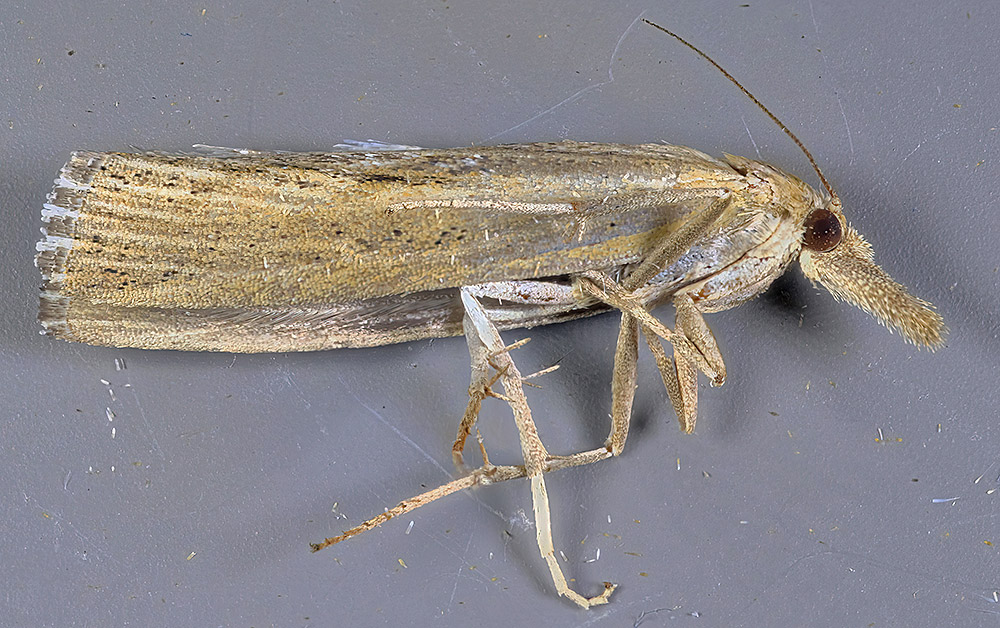
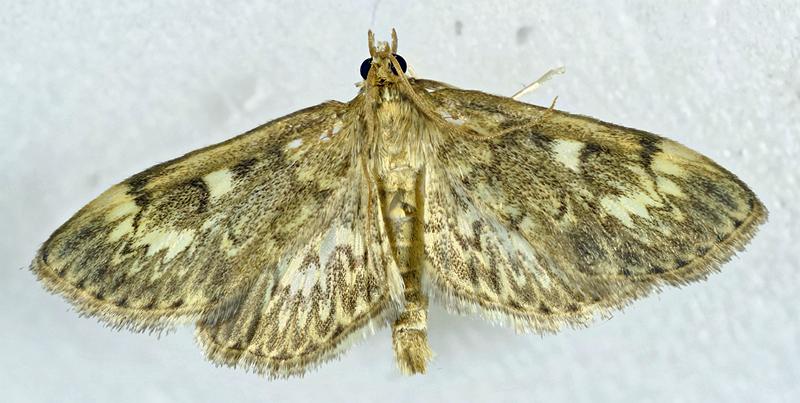

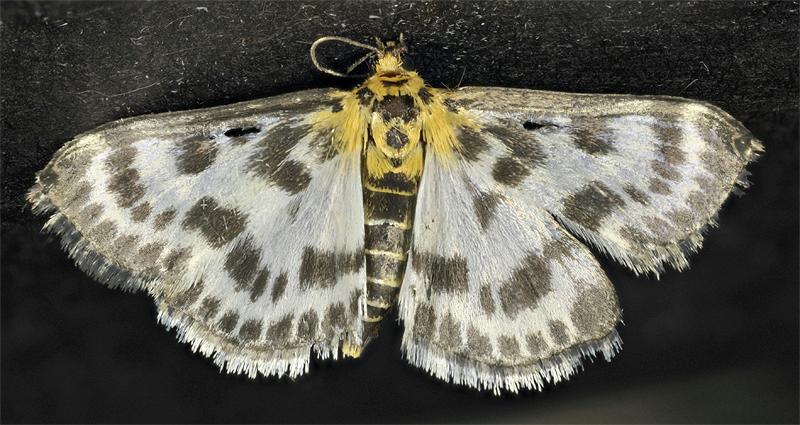

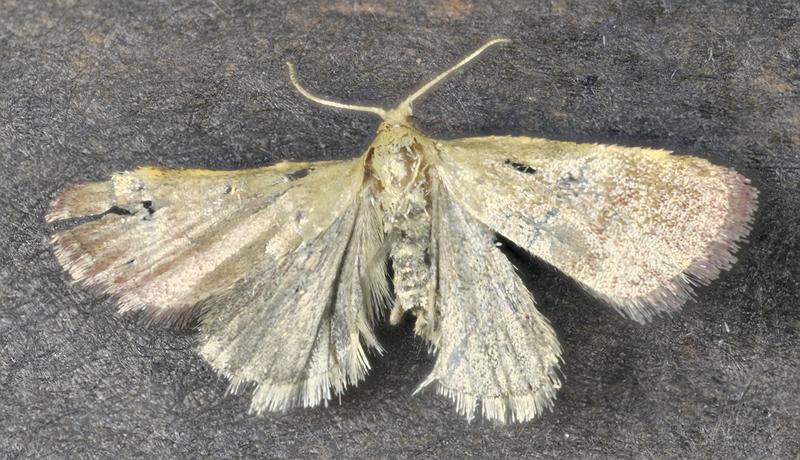

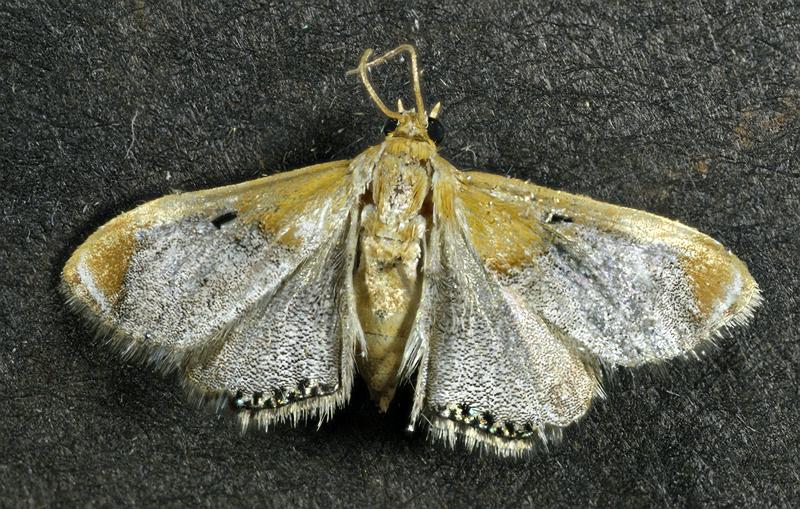

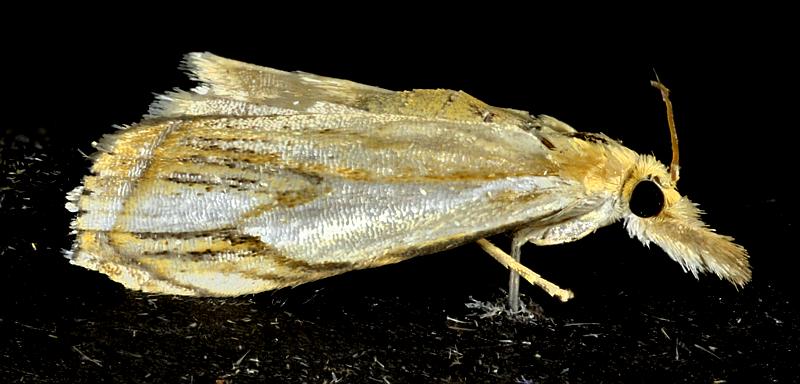

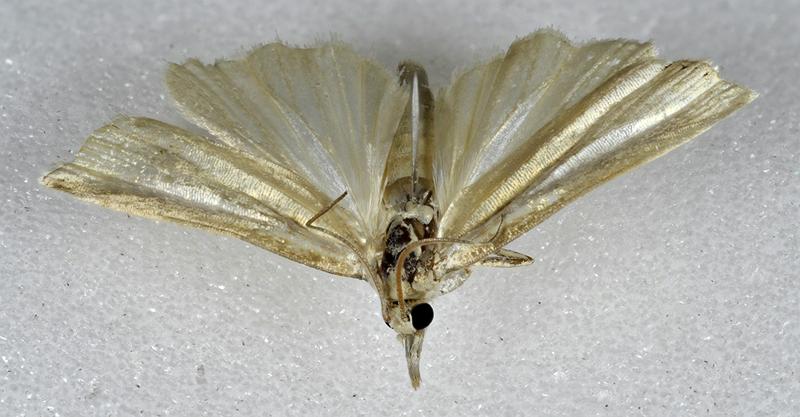

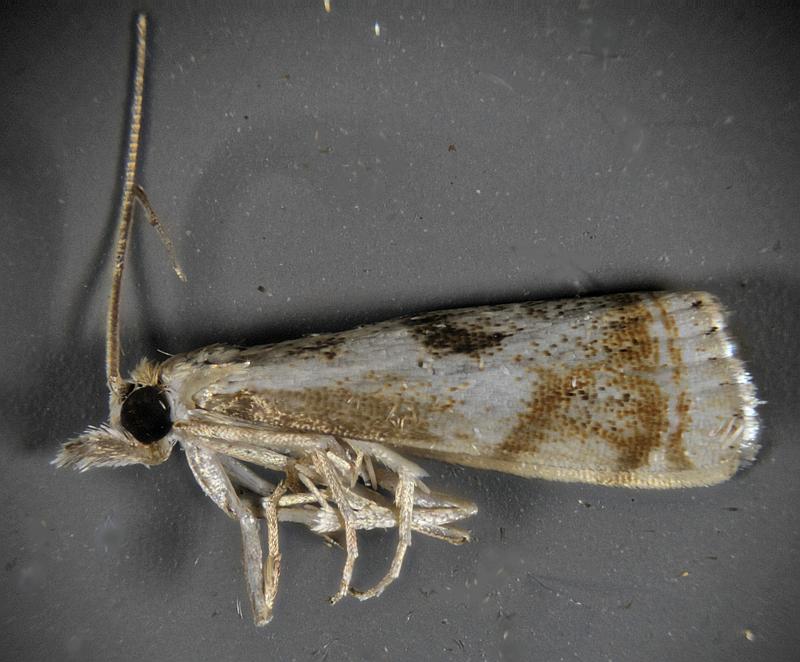

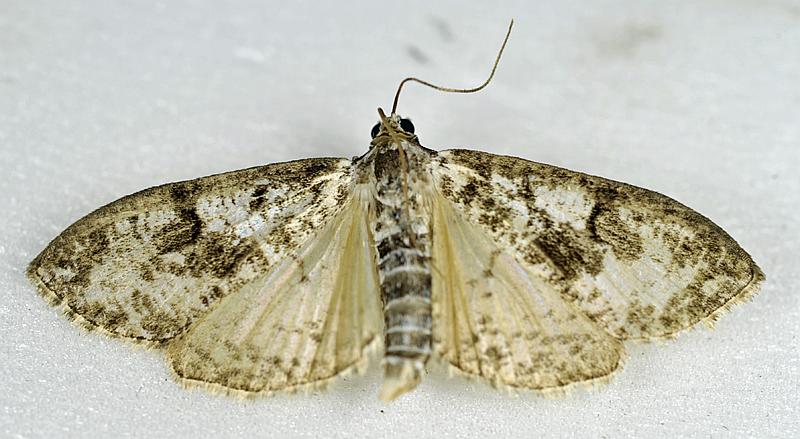

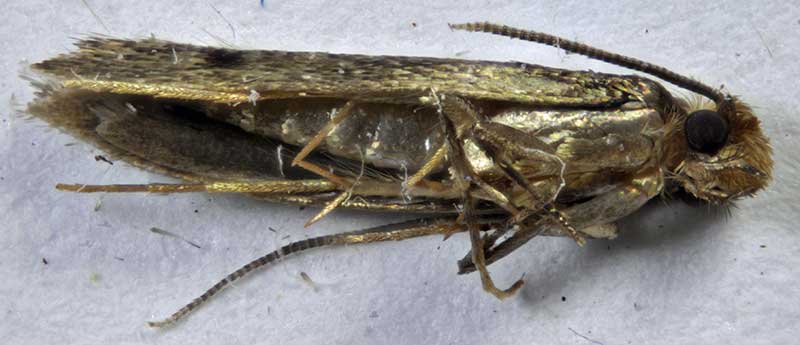

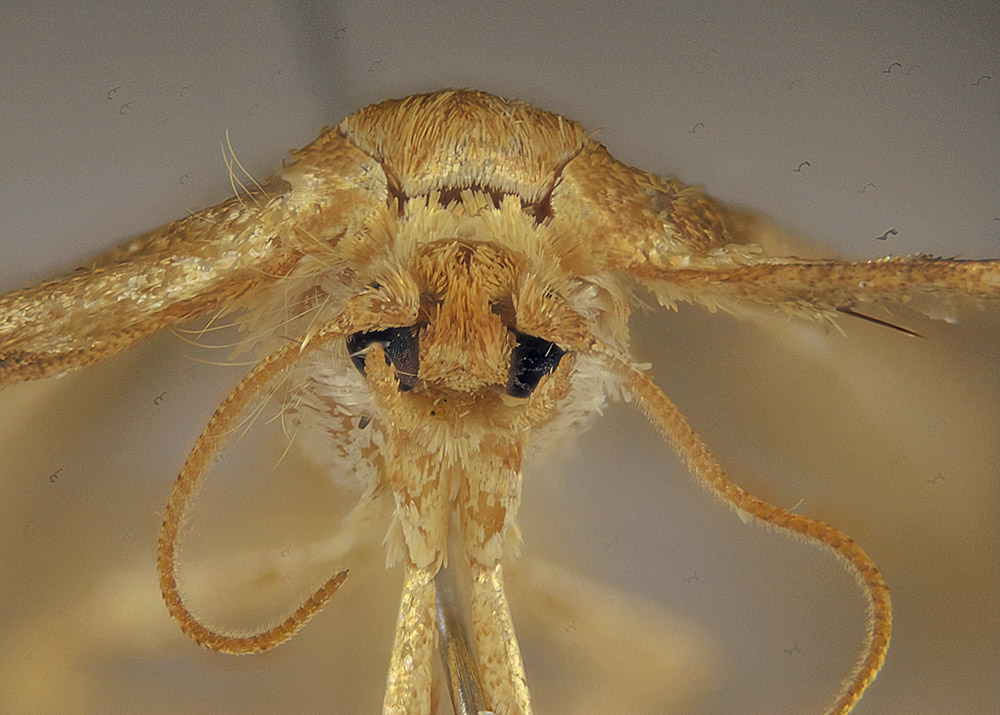

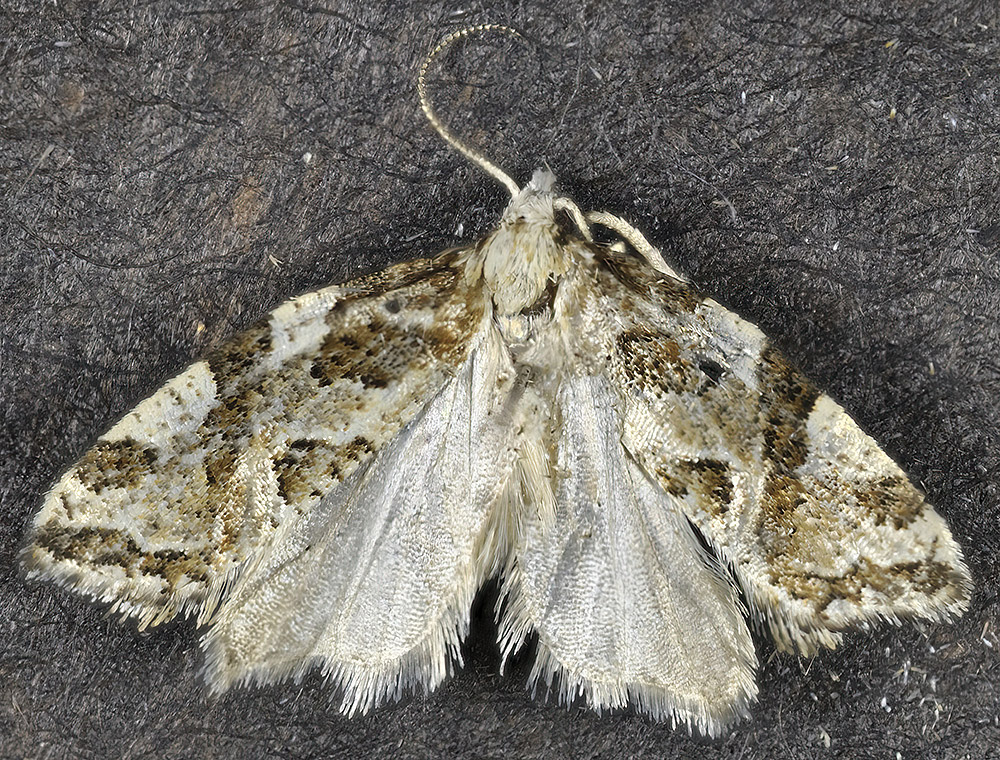

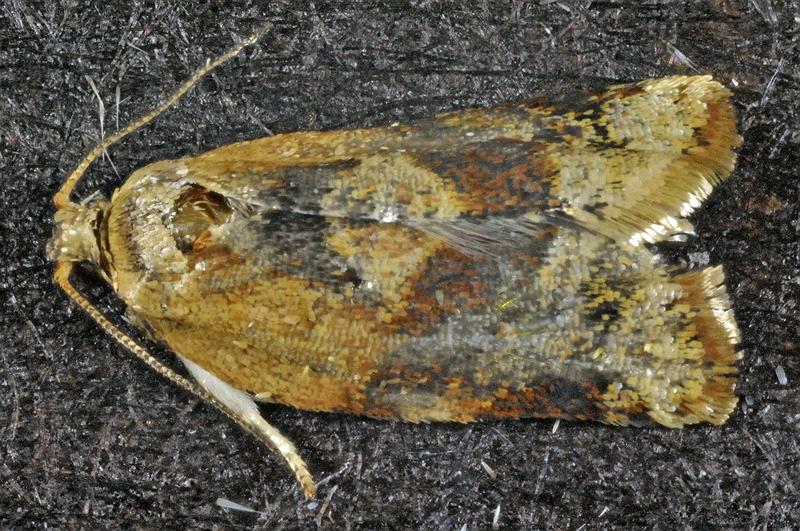

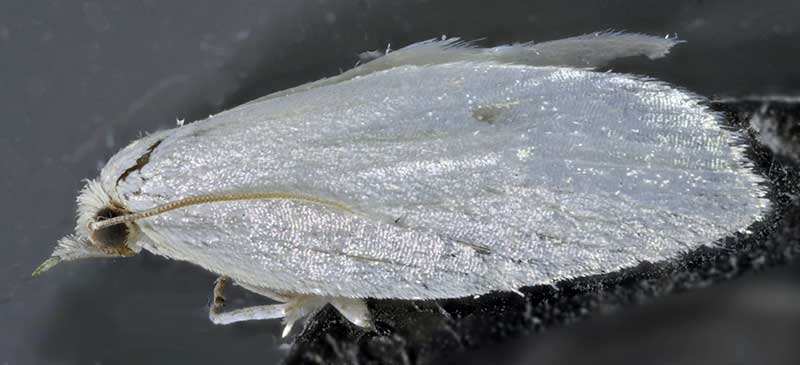

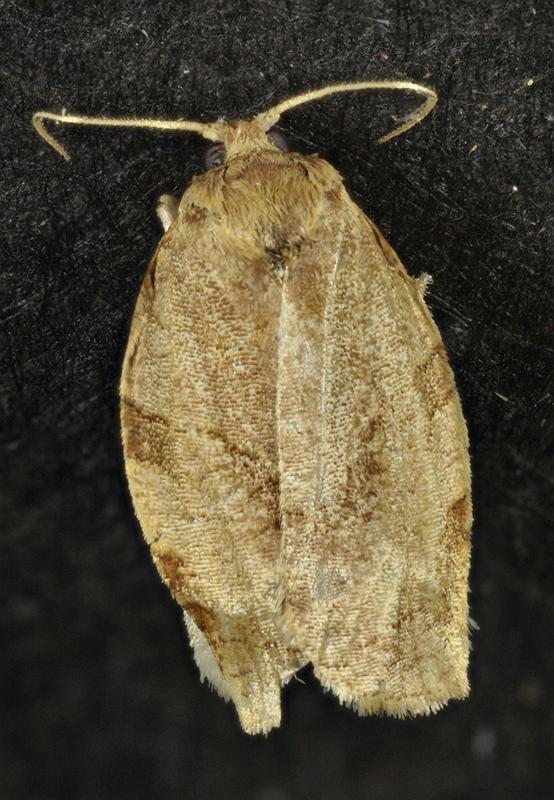

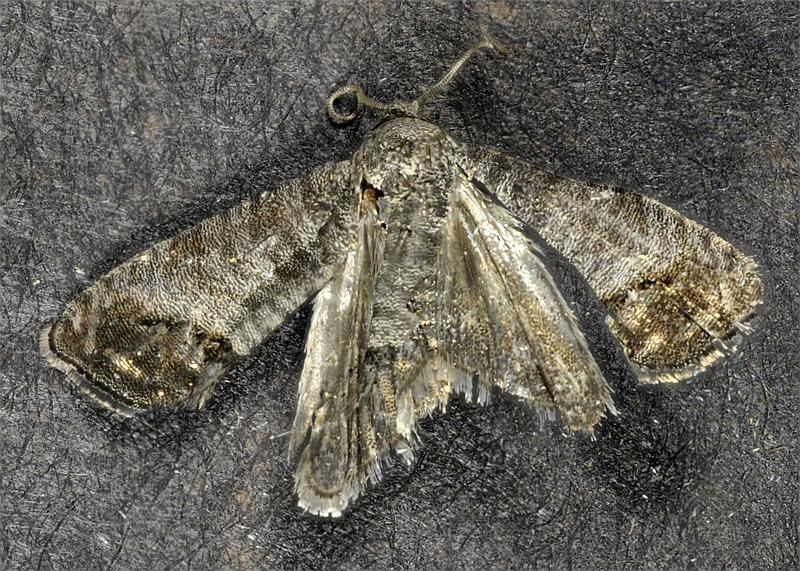

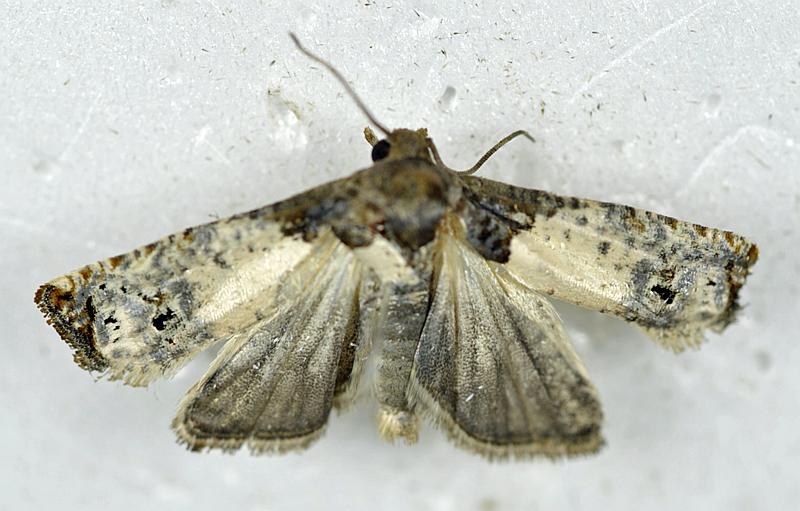

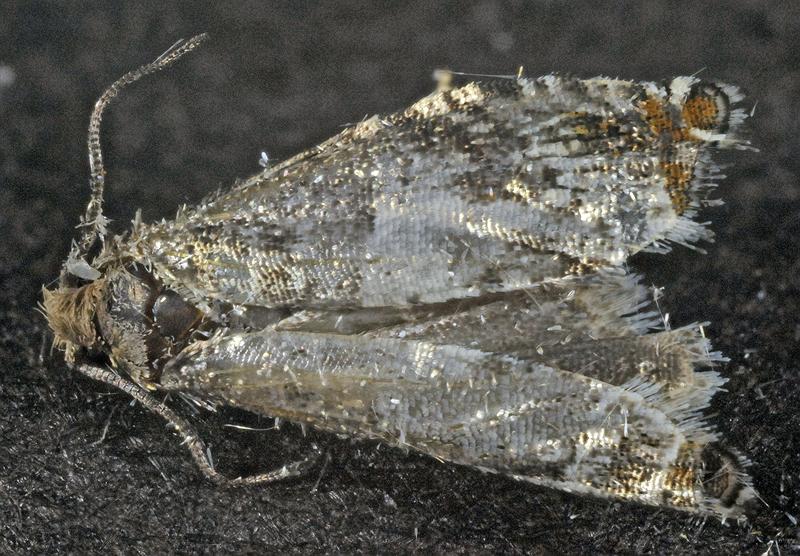

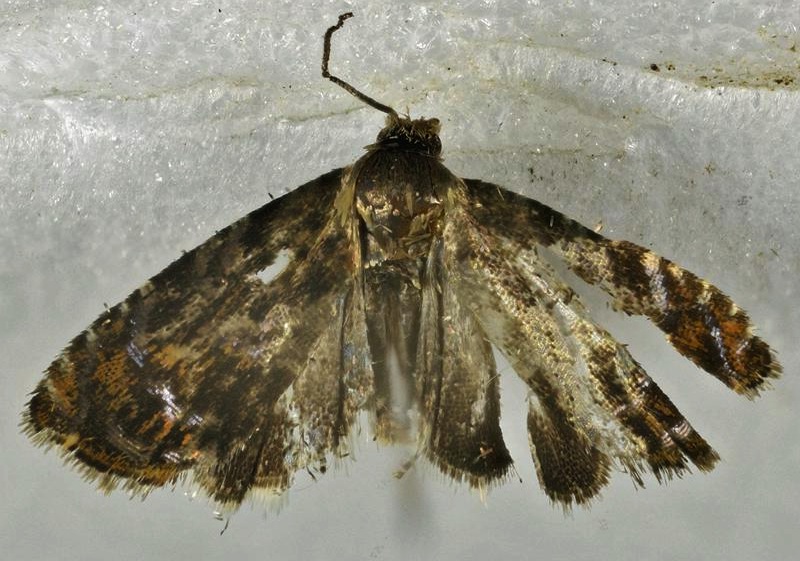

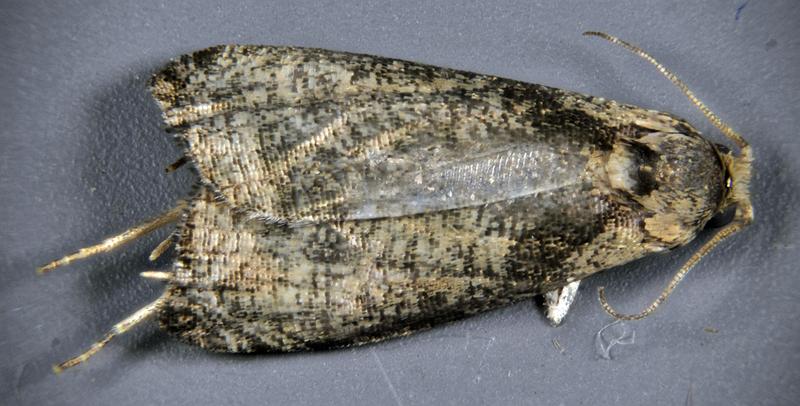

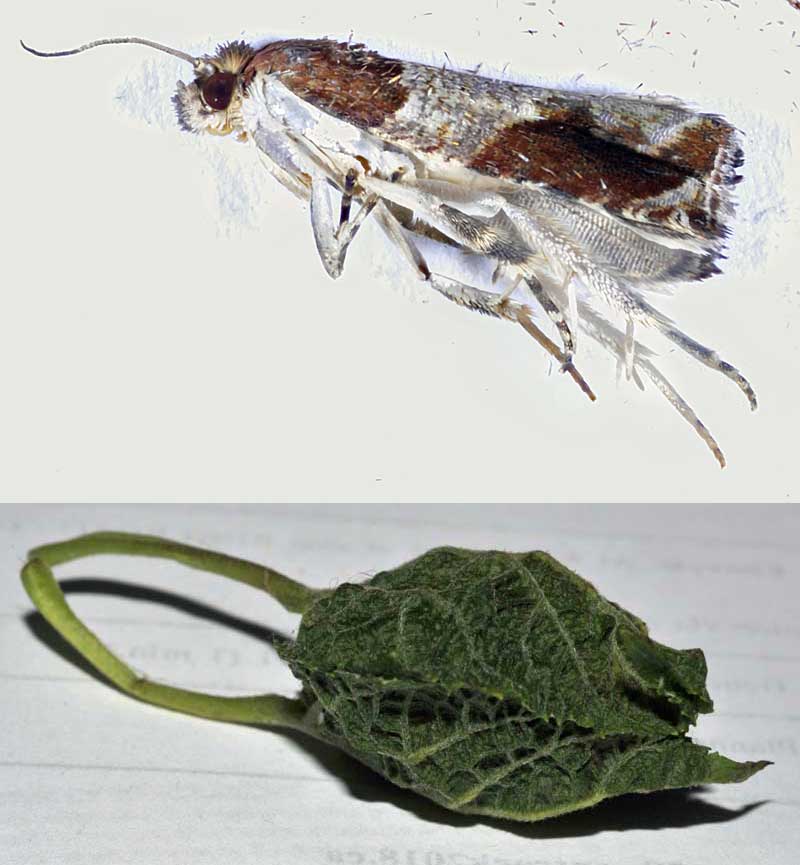

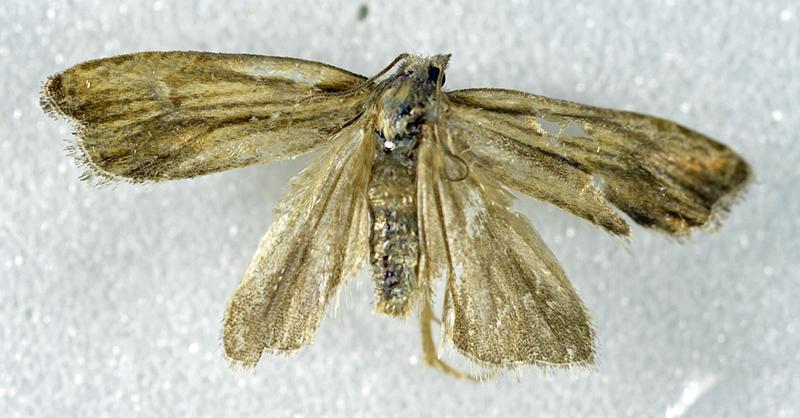

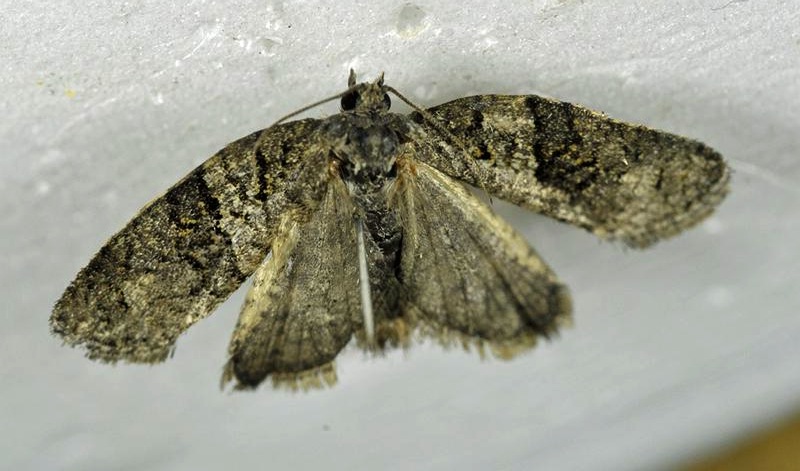

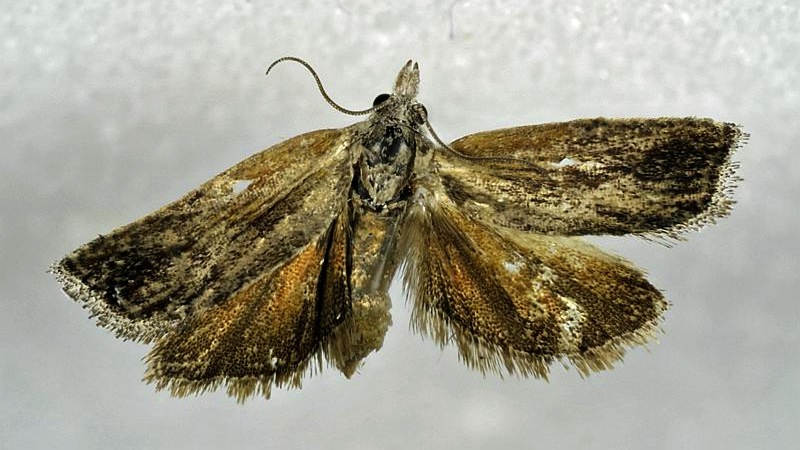

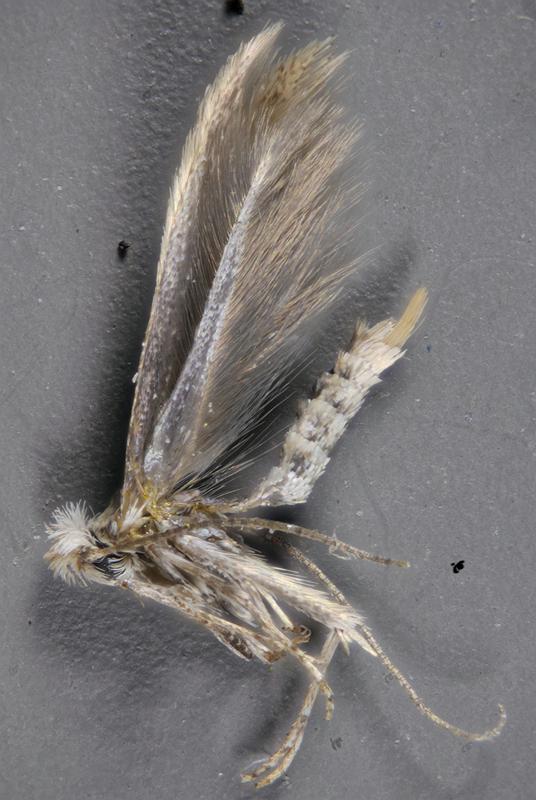


| After trying various powers and types of lights, including a blacklight, to lure nocturnal moths to my urban garden surrounded by concrete and competing street lights, I find I get the best results with a 9W compact fluorescent next to my white aluminum siding; the low power keeps the edge of the garden in darkness which seems to work better than having the entire yard lit up. | mouseover thumbnails for full images |
| Bombycoidea | ||
| Deidamia inscripta: This sphinx moth arrived just as Aquilegia came into bloom. Its larvae feed on Virginia Creeper and wild grapes, both of which are plentiful locally. Body length 23 mm. |


| |
| Gracillarioidea | ||
| Cremastobombycia solidaginis: It's larvae are leaf miners in Solidago. Length 3 mm. |


| |
| Gelechioidea | ||
| Blastobasis: Wing span 16 mm. |

| |
| Blastobasis glandulella: Larvae develop inside acorns. Wing span 9 mm. |


| |
| Coleophora: Body length 6 mm. |


| |
| Gelechia lynceella: Wing span 16 mm. |


| |
| Depressaria depressana: A recent immigrant to North America. Length 7 mm. |


| |
| Holcocera: Wing span 14 mm |


| |
| Machimia tentoriferella: The larva of this moth make a leaf tent for protection; it grows in most eastern Canadian deciduous trees. Wing span 16 mm. |


| |
| Mompha brevivittella: Length 6 mm. |


| |
| Neotelphusa querciella: Wing span 13 mm. |


| |
| Pigritia: Length 5 mm. |


| |
| Sitotroga cerealella: This seed-eating moth now is spread world wide through grain shipments. Length 8 mm. |


| |
| Geometroidea | ||
| Biston betularia: Peppered Moths rest in the upper portion of trees and mimic crustose lichens in insect-visible UV as well as RGB. Wing span 53 mm |


| |
| Cabera variolaria: It's larvae feed on several deciduous tree leaves. Wing span 22 mm |


| |
| Diagrammea continuata: Wing span 20 mm. |


| |
| Dyspteris abortivaria: The larvae of this moth feed on Vitis and Parthenocissus species. Wing span 24 mm. |


| |
| Epirrhoe alternata: A nocturnal moth. Wing span 24 mm. |

| |
| Geometridae: The Geometridae (earth measurer or inchworm) moths are named for their larval locomotion. Length 30 mm. |


| |
| Nematocampa resistaria: Horned Spanworm Moth larvae can feed on most trees and shrubs. Wing span 26 mm. |


| |
| Orthonama obstipata: This moth is at the northern part of its range here. Its larvae feed mostly on Asteridae. Wing span 14 mm. |


| |
| Pasiphila rectangulata: Larvae of the Green Pug moth feed on fruit tree blossoms. Wing span 21 mm. |


| |
| Scopula limboundata: These moths rest with the wings as shown, flattened against a leaf. Wing span 30 mm. |


| |
| Scopula septentrionicola: Wing span 22 mm. | 

| |
| Speranza pustularia: Wing span 41 mm. |


| |
| Trichodezia albovittata: The larvae of this moth feed on Impatiens. Wing span 18 mm. |


| |
| Xanthorhoe ferrugata: A nocturnal moth. Wing span 18 mm. |


| |
| Xanthorhoe lacustrata: A nocturnal moth. Wing span 24 mm. |


| |
| Xanthotype sospeta: DNA evidence is that this moth and X.urticaria are the same species; sospeta has priority. A diurnal moth. Wing span 35 mm. |


| |
| Hesperioidea | ||
| Carterocephalus palaemon: Arctic Skippers are uncommon visitors in early June; their larvae grow on grasses such as Bromus inermis that is plentiful in the nearby meadow. Wing span 30 mm. |


| |
| Poanes hobomok: Hobomok Skippers are common in the nearby meadow. Wing span 30 mm. |


| |
| Lasiocampoidea | ||
| Malacosoma disstria: Forest tent caterpillars don't build tents, instead they form tight swarms on trunks of trees. Their numbers fluctuate on a decade time scale, unlike their tent-spinning cousins. This one was offered a variety of local leaves and chose basswood. |


| |
| Lycaenidae | ||
| Celastrina ladon: The larvae eat buds of dogwoods, blueberries and viburnums; adults are usually found in damp places: marshes, woods, swamps. I only saw one in my gardens, mid-May, too briefly to obtain a photo, but it was unmistakable. | ||
| Noctuoidea | ||
| Alypia octomaculata: Eight-spotted Foresters are found in spring wherever there is Parthenocissus quinquefolia for their larvae. Wing span 30 mm |


| |
| Caenurgina crassiuscula: Clover Looper larvae feed on grasses and clovers. Wing span 28 mm. |


| |
| Calophasia lunula: native to Europe, was first introduced to Canada in the early 1960s as an agent of biological pest control against Linaria vulgaris in areas where they are considered noxious weeds. Those of us who call the flowers butter&eggs pick them off when we find them in our gardens. Length 16 mm. |


| |
| Catocala grynea: Woody Underwing larvae feed on Crataegus, Prunus and Malus. Wing span 45 mm. |


| |
| Cisseps fulvicollis: Larvae feed on grasses, adults take nectar. Wing span 32 mm. |


| |
| Digrammea continuata: Splitters insist that by dissecting this moth they can discern 3 species; it's larvae feed on Juniperus virginiana and Thuja occidentalis, both of which are common here. The species overwinters in the pupal stage in soil or amongst debris; Wing span 20 mm. |


| |
| Euclidia cuspidea: A diurnal moth whose larvae feed on grasses and clovers. Wing span 28 mm. |


| |
| Euxoa obeliscoides: This moth overwinters as an egg; nothing is known of the larvae. Wing span 32 mm. |


| |
| Feltia mollis: Wing span 33 mm. |


| |
| Hypena scabra: The Green Cloverworm Moth migrates from the southern USA each year and produces two generations here. Wing span 35 mm. | 

| |
| Hypenodes fractilinea: Length 6 mm. one of the smallest Noctuidae. | 

| |
| Idaea aemula: Wing span 24 mm. |


| |
| Idaea dimidiata: A holarctic species native to Europe. Wingspan 14 mm. | 

| |
| Lacinipolia renigera: Bristly Cutworm larvae feed on almost any herbaceous plant. Wing span 27 mm. | 

| |
| Leucania pseudargyria: The furry legs of these moths really stands out. Wing span 40 mm. |


| |
| Leuconycta diphteroides: Green Owlet larvae feed on Solidago and Aster. Wing span 31 mm. |


| |
| Lophocampa caryae: Hickory Tussock Moths feed primarily on hickory, pecan and walnuts. Length 25 mm. |


| |
| Lymantria dispar: Gypsy moth larva. Length 25 mm. |

| |
| Maliattha synochitis: The larva of this moth feed on Polygonum and grasses. Wing span 18 mm. |


| |
| Megalographa biloba: This moth is a migrant here; its larvae love huge monoculture fields of lettuce. Wing span 40 mm. |


| |
| Mythimna unipuncta: Armyworm moths are common at porch lights throughout North America, the larvae feed on most plants. Body length 20 mm. |


| |
| Neoligia exhausta: Wing span 22 mm. |


| |
| Nephelodes minians: wingspan 30 mm. |


| |
| Palthis angulalis: A nocturnal moth, the feathery parts are the labial palps. Wing span 24 mm. (The pin is 200 µm, the smallest I can find.) |


| |
| Phlogophora iris: Wing span 38 mm. |


| |
| Platypolia mactata: Wing span 36 mm. |


| |
| Ponometia erastroides: Wing span 18 mm. |


| |
| Pyrrharctia isabella: Banded Woollybear caterpillars eat a wide variety of grasses and leaves and overwinter as caterpillars, when they survive by producing ice-structuring proteins in their tissues that prevent ice crystals from forming within their cell walls. In the spring they thaw out, then look for a place to pupate, as this one is doing. Adults live only a few days so are rarely seen, but after more than a decade keeping my eyes open, here's one! caterpillar length 35 mm, adult length 25 mm. |



| |
| Pyrrhia exprimens: found on Aquilegia along with many Pieris rapae caterpillars. |


| |
| Spilosoma virginica: Little is known about the Yellow Woollybear moth. Wing span 50 mm. |


| |
| Virbia ferruginosa: Wing span 30 mm. |


| |
| Zale phaeocapna: Larvae of this moth feed on Corylus cornuta and C.americana. Wing span 37 mm. |


| |
| Zale unilineata: Wing span 37 mm. |


| |
| Zanclognatha cruralis: Wing span 28 mm. |


| |
| Zanclognatha pedipilalis: A nocturnal moth that flies from May through August. The larvae feed on dead leaves. Wing span 28 mm. |


| |
| Papilionoidea | ||
| Aglais milberti:Milbert's Tortoiseshell are occasional in the nearby meadow. Only one sighting in my backyard. Wing span 45 mm. |


| |
| Cercyonis pegala: Common Wood Nymphs are common in the nearby meadow. Wing span 50 mm. |


| |
| Coenonympha tullia: Common Ringlets are found wherever healthy grass grows. Wing span 35 mm. |


| |
| Colias philodice: Common Sulphurs fly here from mid-May to late September. Wing span 44 mm. |


| |
| Danaus plexippus: Monarchs appear mid-June as Asclepias syriaca begins to bloom in the neighbouring meadow and continue to visit throughout the summer. They work their way north from winter hibernation sites in Mexico in three generations; the 4th generation flies all the way back to hibernate. Silphium perfoliatum is their favourite in my garden. Wing span 100 mm. |


| |
| Euphydryas phaeton: Baltimores are rare visitors late June and early July; their larval preference Chelone glabra isn't found nearby. Wing span 60 mm. |


| |
| Feniseca tarquinius: Harvesters are unique in North America in that the adults feed mostly on woolly aphid sugar excretions while the larvae are carnivorous on woolly aphids themselves. It's believed that they smell like aphids to deter attacks by ants that normally protect aphids from predators. They appear late May, then mid-July to mid-August. Wing span 25 mm. |


| |
| Glaucopsyche lygdamus: Silvery Blues visit mid-May to late June, and are usually seen settled on the ground to sun themselves. Their larvae grow on Fabaceae, common in the nearby meadow. Wing span 30 mm. |


| |
| Limenitis arthemis: White Admirals are rare visitors mid-June through July. Their larvae grow on Betula which is not common locally due to unsightly defoliation by Fenusa pusilla. Wing span 90 mm. |


| |
| Lycaena phlaeas: Little Coppers visit mid-June and late August; its larvae feed on Rumex, several of which are plentiful in the nearby meadow. Wing span 25 mm. |


| |
| Nymphalis antiopa: Mourning Cloaks are the earliest butterfly to appear here, sometimes as early as the first week of April since they overwinter as adults by producing glycerol antifreeze that allows them to survive -34 C. Their larvae feed on Salix and related genera. The bright yellow of their wings fades, as in this example, since they have one of the longest adult life spans of any butterfly - up to 12 months. Wing span 70 mm. |


| |
| Papilio glaucus: Tiger Swallowtails overwinter here as pupae, then fly by during June; their larvae mostly grow on Rosaceae, common in non-yellow gardens here. Wing span 120 mm. |


| |
| Papilio polyxenes: Black Swallowtail larva feeding on young seed heads of Zizia aptera |


| |
| Phyciodes cocyta: Northern Pearl Crescents visit June to early September; their larvae grow on the plentiful Asteraceae in the nearby meadow. Wing span 35 mm. |


| |
| Pieris rapae: Cabbage Whites are native to Europe, first appeared in North America in Quebec in the 1860s and are now ubiquitous across the continent. They appear here early May and are common well into September. Wing span 50 mm. |


| |
| Polygonia comma: Eastern Commas are rare visitors; wing span 70 mm. |


| |
| Vanessa atalanta: The leading edge of the earliest and largest migration of Red Admirals on record: 17 April 2012. Several dozen stayed in the garden for almost a month feeding on Ribes nigra and R.aurea blooms. Wing span 45 mm. |


| |
| Vanessa cardui: Part of a large migration of Painted Ladies, 19 September 2017. Wing span 55 mm. |


| |
| Pterophoroidea | ||
| Cnaemidophorus rhododactyla: The larvae of this Pterophorinae feed on Rosacea. Wingspan 24 mm. |


| |
| Dejongia lobidactylus: The larvae of this Pterophorinae eat Solidago, which are plentiful locally. Wingspan 12 mm. |


| |
| Gillmeria pallidactyla: The larvae of this Pterophorinae eat most plants. Wingspan 26 mm. |


| |
| Thyris maculata: Larvae of this moth feed on Clematis and Houstonia. Wing span 12 mm. |


| |
| Pyraloidea | ||
| Aglossa pinguinalis: It's larvae feed on grasses. Wing span 41 mm. |

| |
| Agriphila vulgivagellus: It's larvae feed on grasses. Length 15 mm. |

| |
| Anania coronata: Crowned Phlyctaenia larvae feed on Viburnum, Syringa and commercial sunflower. Wing span 22 mm |


| |
| Anania hortulata: Small Magpie larvae feed on Stachys and Mentha, the adults mostly on Urtica. Wing span 27 mm |


| |
| Arta olivalis: Wing span 16 mm. |


| |
| Chalcoela iphitalis: It's larvae feed on the larvae of Polistes wasps. Wing span 19 mm. |


| |
| Crambus leachellus: Snout-nosed moths are nocturnal. This one is easily recognized when resting by the reflective silver streak on its forewing and its long palps. Wing span 20 mm. |


| |
| Crambus praefectellus: It's larvae feed on grasses and their seeds. Wing span 20 mm. |


| |
| Microcrambus elegans: Elegant Grass-veneer Moth larvae live on Poaceae. Body length 7 mm. |


| |
| Palpita magniferalis: A nocturnal moth. Wing span 28 mm. |


| |
| Tineoidea | ||
| Tineinae: Tineids eat living plants, fungi, lichens, and detritus. The most known members of the family are the clothes moths that eat fabrics, especially woollens. Wing span 12 mm |


| |
| Tortricoidea | ||
| Acleris semipurpurana: The larvae of this moth hatch in April on red oaks, make a shelter by tying leaves together with silk and, after eating their fill of buds and leaves, descend on a silk thread to the forest floor to pupate in May, emerging in June to lay more eggs for the next year's population. Wing span 20 mm |


| |
| Aethes angulatana: Wing span 13 mm |


| |
| Argyrotaenia velutinana: Redbanded Leafroller larvae feed primarily on Prunus and Picea, but also some vegetables, overwintering as a pupa in folded leaves on the ground. Wing span 13 mm. |


| |
| Cenopis pettitana: A major food source of this moth's larvae is basswood; I'm surrounded by it. Length 14 mm. |


| |
| Choristoneura rosaceana: Its larvae roll up and eat leaves of apples and Rosacea. Length 9 mm. |


| |
| Cydia pomonella: Larvae of the Codling Moth are the most common 'worms' in apples. Wingspan 16 mm. |


| |
| Epiblema scudderiana: The Goldenrod Gall Moth overwinters as a final stage larva within a gall. It survives -37 C by producing antifreeze proteins and glycerol in its tissues. Wing span 17 mm. |


| |
| Epinotia transmissana: Almost nothing is known about this moth. Wing span 16 mm. |


| |
| Grapholitini: Wing span 8 mm |


| |
| Olethreutes exoletum: Wing span 15 mm |


| |
| Olethreutes ferriferana: Its larvae feed on Hydrangea. Wing span 15 mm |


| |
| Olethreutinae: Wing span 19 mm |


| |
| Syndemis afflictana: Larvae of this moth feed on conifers, birches and willows. Wing span 20 mm. |


| |
| Tortricinae: The larvae of these moths feed on fruits. Wing span 15 mm. |


| |
| Yponomeutoidea | ||
| Bedellia somnulentella: Sweet Potato Leaf Miners are now cosmopolitan. The abdomen constriction at the base and high attachment on the thorax is common in the more slender microleps, but not usually seen. Length 4.5 mm |


| |
| Plutella xylostella: Plutellidae are uniquely identified by the long forward tufts on the second segment of the labial palps. Diamondback Moth originated from the Mediterranean but has now spread world wide to wherever glucosinolate-containing Cruciferae grow, especially Brassica oleracea (cabbage, broccoli, cauliflower, kale, Brussels sprouts). Wing span 14 mm. |

|
John Sankey 2012...
other insects in the garden
The Moths of Canada
Moth Photographers' Group
Illustrated Guide to Microlepidoptera
I thank Dr. Don Lafontaine of Canacoll for generous assistance with several of the identifications here.